




Located right on the seafront, The Shoreline provides an unmatched combination of high-end living spaces, breathtaking vistas, and a wealth of community features.


EDITORIAL AND DESIGN
TBWA\ANG
EXECUTIVE EDITOR
Fiona Galea Debono
SALES AND BUSINESS DEVELOPMENT
TBWA\ANG
CONTRIBUTORS
Air Malta
Adriana Bishop
Charlene Vella
Charlotte Stafrace
Deirdre Farrugia
Din l-Art Ħelwa
Juan Ameen
Malta Maritime Museum
Michele Tufigno
Thomas Camilleri
VisitGozo/Ministry for Gozo
WOULD
For
PHOTOGRAPHERS
Aaron Kerr
Adriana Bishop
Albert Pisani
Daniel Cilia
Focus Fotos
Jeff Fabri
Joe Quattromani
Josef Agius
Katrina Demarco
Kovexdi Photography
Mark Zammit Cordina
Olha Ruccya
Palazzo Falson
Historic House Museum
Paul Mangion
Piotr Andruszko
Scarlett Stafrace
Shaun Sultana
Steven Psaila
Tyler Calleja Jackson
ILLUSTRATOR
Bryan Wolfgang Reiter
2131 0608 and +356 9929 0518.
For anything related to editorial or photography, contact editor@il-bizzilla.com





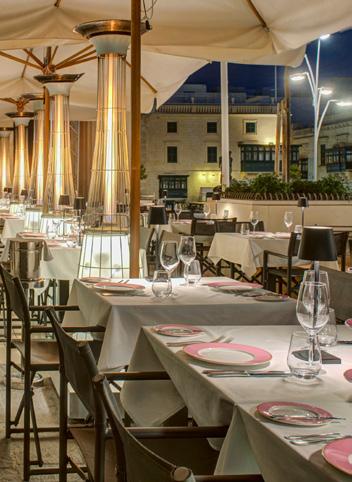



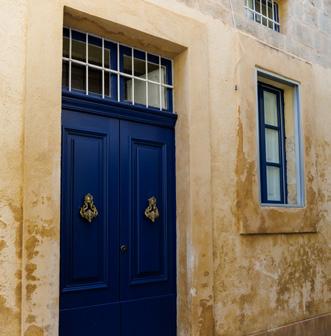
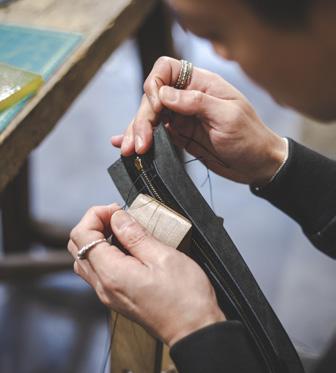
p. 10
CITTÀ ROHAN
A-Z of Żebbuġ.
p. 16
FAR MORE THAN YOU MIGHT THINK
Taking a closer look at Catania.
p. 22
EASTER IN MALTA: TRADITION AND DEVOTION
Join in the Catholic Church’s biggest celebration.
p. 29
EMERGING DIMESIONS
The many layers of Lewis Zammit’s abstract art.
p. 36
RIDE THEM, DON’T HIDE THEM
Behind the wheel of vintage motorcycles.
p. 42
AN ISLAND AT THE CROSSROADS
Malta Maritime Museum exhibition on the surrounding sea.
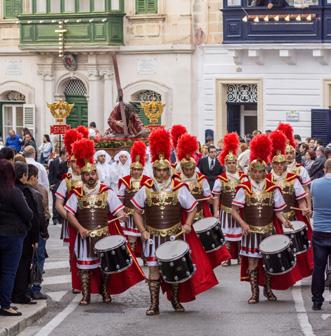

p. 44
EASTER IN GOZO
Your guide to living the tradition.
p. 50
MALTA’S CULTURAL SPRING
Making its debut in the international biennale scene.
p. 54
A CUT ABOVE THE BLUE
Local leathersmiths craft their luxury designs.
p. 60
PRIME POSITION
Welcome to Wignacourt Tower.
p. 62
HISTORICAL MALTA FOR KIDS
A child-friendly holiday destination.
p. 68
THE WOW FACTOR
Meet the curator of St John’s Co-Cathedral.
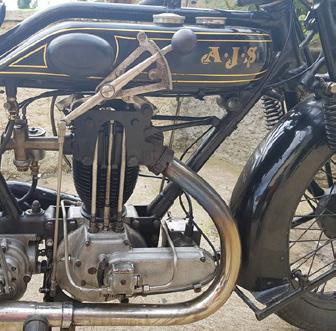

p. 72
GAME, SET, MATCH!
Tennis as a lifestyle on the island.
p. 75
THE MAKING OF AN ICON
Try the pastizzi experience from scratch.
p. 86
AIR MALTA NEWS
A round-up of this month’s events and activity.
p. 93
DESTINATION INFORMATION
Check out the route map and direct destinations.
p. 94
FLIGHT AND COMPANY FACTS
All you need to know about flying with Air Malta.
p. 96
ABOUT ELECTRONIC DEVICES
Phone, laptop and tablet usage on board.
p. 10 p. 54 p. 72 p. 75 p. 22 p. 36
Dear travellers,
Spring is a time of new beginnings and fresh starts.
The season barely has a chance to surface on the islands before summer takes over and smothers it. But the Easter holidays can offer a window of the most welcoming weather, allowing visitors to enjoy the best that Malta has to offer.
The Easter celebrations, and their accompanying traditions, are the focus of the March issue. They combine culture with colour, pageantry with passion, rituals with revelry. They are events that show up Malta’s unique character and identity, and the programmes for both islands, outlined in the pages of Il-Bizzilla , are a good reference for tourists and locals alike. Whether this is all new to you, o r part of your beliefs, visiting candlelit churches, following the Good Friday processions, joining in the Easter Sunday jubilation, and getting a taste of the culinary traditions too should be on anyone’s agenda this month.
And if you are travelling to Malta with children, or returning home and simply want to fill up their Easter break in a fun, innovative – and even edifying – way, be sure to read our guide to a child-friendly island. It lists, from first-hand experience, the many historical sites that won’t leave the kids yawning away, while injecting an element of education into their holiday. How’s that for a win-win situation!
Once again, Il-Bizzilla is big on art in a variety of shapes and forms. Apart from upcoming exhibitions and performances for the month of March, it shines a spotlight on the artisans designing luxury leather goods from their quaint stores in historical centres. And riding a vintage motorcycle is also considered an art, according to Malta’s Historic Motorcycle Club, which explains why it’s not about the destination but the journey…
The maltabiennale.art has naturally found its place in the magazine – the country’s cultural spring as it marks its debut on the international contemporary art biennale scene. Artists from around the world will converge on the island to explore the thought-provoking the mes of modern Mediterranean identity, so be prepared to follow their trail from one heritage site to the next.
Yes, while this may be the last issue of Il-Bizzilla , spring is a time for new beginnings... as the national airline, Air Malta, flies off into the horizon and the new flag carrier KM Malta Airlines gets ready for take-off next month.
Fiona EDITOR


NORTHERN EUROPE & BRITISH ISLES - STARTING FROM €179

MEDITERRANEAN - STARTING FROM €149
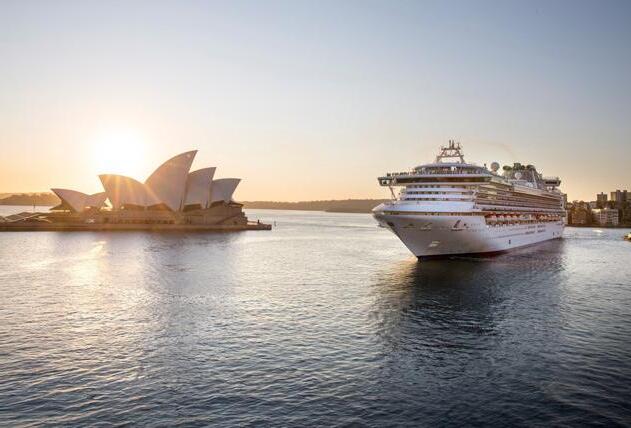
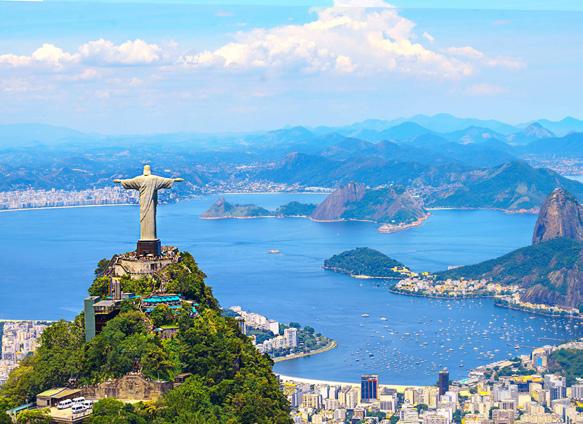 NORWEGIAN FJORDS - STARTING FROM €809
ALASKA - STARTING FROM €479
NORWEGIAN FJORDS - STARTING FROM €809
ALASKA - STARTING FROM €479

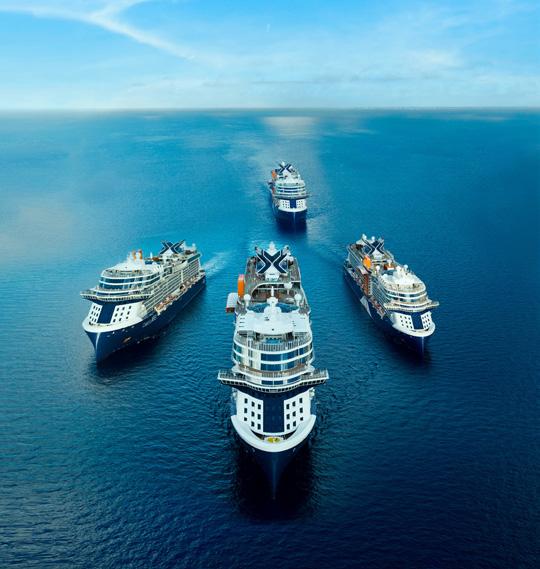


A multi-destination vacation without changing rooms or re-packing luggage sounds more than an ideal vacation! You not only get to visit multiple destinations but the ship is a destination in itself, with great amenities, amazing culinary options and the best entertainment!
Most expenses are included in the cost of the cruise, so effectively you never need to open your wallet - and that means a lot of saving! The ship is accommodation and transport combined, getting you to some wonderful destinations in style and housing you along the way. Food is also served all day, so you need never go hungry or pay for a bite to eat if you don’t want to!
Cruising is a huge time saver when you take a cruise, you are on holiday from the moment you step onboard.
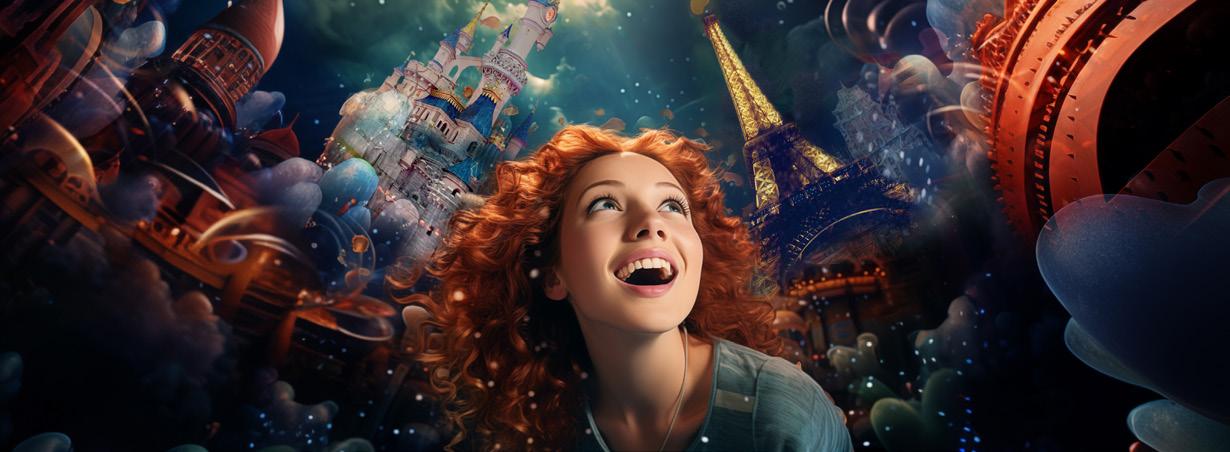


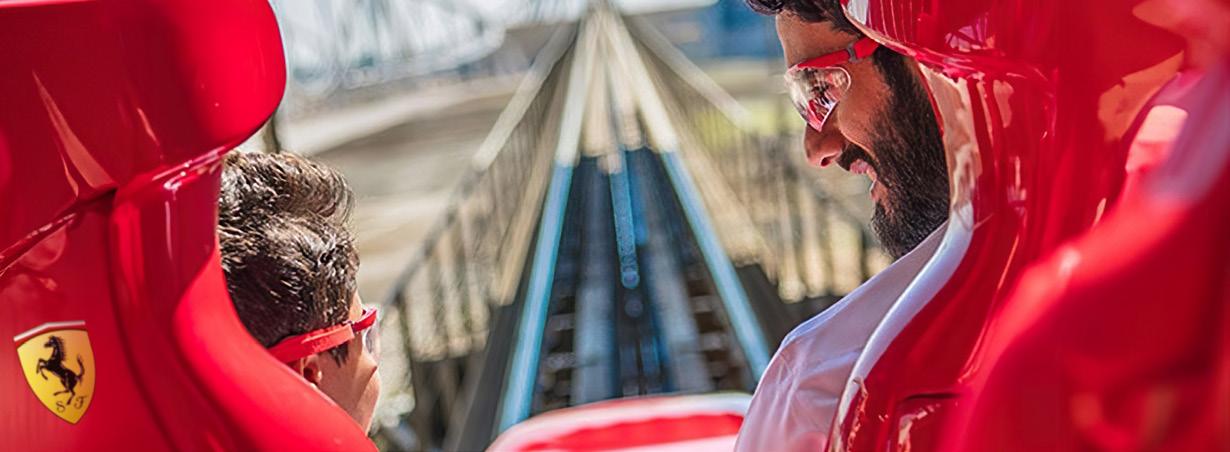 PARIS
PARIS
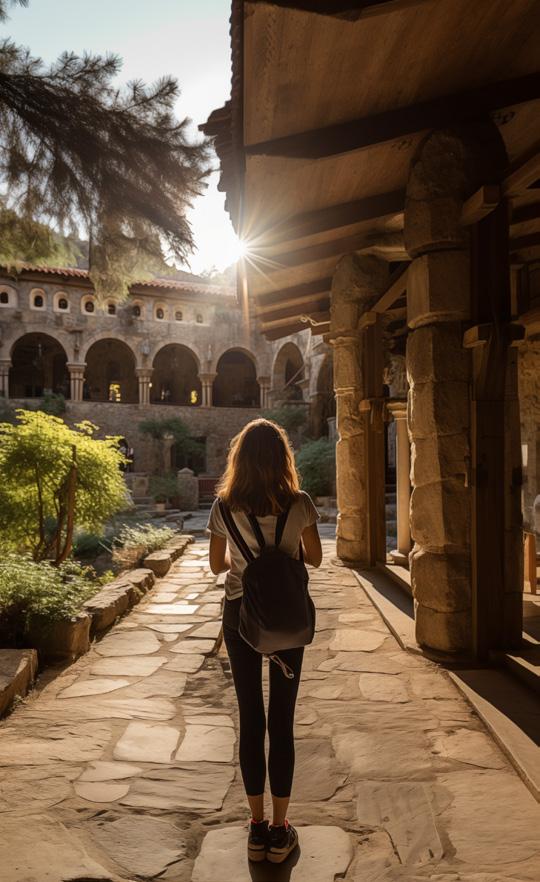


Our family destinations offer an array of exciting opportunities tailored specifically for families, ensuring a memorable experience for all.
From charming cities to sun-kissed beach resorts, each destination is handpicked to cater to diverse tastes and preferences. Whether you’re seeking thrilling theme parks, cultural immersion, or tranquil retreats, we provide an extensive selection of options to suit every family’s needs.
With our expert guidance and seamless booking process, planning your family getaway has never been easier. From accommodations to activities, every aspect of your trip is carefully curated to ensure a hassle-free and enjoyable experience for the whole family.
Embark on a journey of discovery, laughter, and cherished moments with ROCS Family Destinations, where unforgettable memories are made.
THIRTEEN CHAPELS, THREE BAND CLUBS, TWO FEASTS; THE BIRTHPLACE OF POETS AND PATRIOTS… THAT’S ŻEBBUĠ FOR YOU, AND ITS INHABITANTS ARE PROUD TO CALL IT HOME.
The place I live in is called Ħaż-Żebbuġ (the Maltese word for olives) and I am lucky to call it my home for the last 30 years. I am also pleased to say the town still retains a lot of the original village core feeling, which I fell in love with all those years ago.
While tourists fall head over heels in love with the beauty of the palazzos and old buildings in places like Mdina and Rabat, if they venture beyond, they can find similar winding roads, magnificent churches, an abundance of chapels and palazzos, and corner statues carved in stone, that make up some of the interesting fabric of Żebbuġ. Insight into the stories behind some of these buildings can also make for a fascinating read.
In Malta, up to the 19th century, drought and plagues were the order of the day, resulting in heavy losses to its population. So, in Żebbuġ, we have a total of 13 chapels, built as offerings, pledges, or to invoke the protection of saints when faced with these epidemics. The town’s best example of this is the small, beautiful and oldest chapel dedicated to St Roque, the patron saint of the plague, dating to 1592, which can still be visited by appointment.
Żebbuġ is also one of Malta’s oldest settlements, situated in the centre of the island, and although its origins date back to around
1436, some historians claim it is actually even older – all the way to the Copper Age. Originally made up of three hamlets, Ħal Mula, Ħal Dwin and Ħal Muxi, these converged into one village and went on to become a town, Żebbuġ, whose name was derived from the Arabic word for oli ves. These olive trees grew abundantly in the wild but were also cultivated in the surrounding rich agricultural land.
Żebbuġ also became known as Città Rohan, a title bequeathed by Grand Master Emmanuel de Rohan-Polduc back in 1777, and that is still coveted today. In recognition of this honour, a triumphal arch was erected at the entrance to the town centre, and still stands today.
Żebbuġ’s prominence kept on increasing, and during the 18th century, it went on to become home to some of the wealthiest people in Malta, as well as the birthplace of more patriots and heroes than any other town. Suffice it to say that both national poet Dun Karm Psaila and Mikiel Anton Vassalli, the father of our own Maltese language, together with a host of sculptors, musicians and politicians, hailed from Żebbuġ.
As with other villages in Malta, in the 1980s, the boom for converting old houses started, and Żebbuġ became popular with



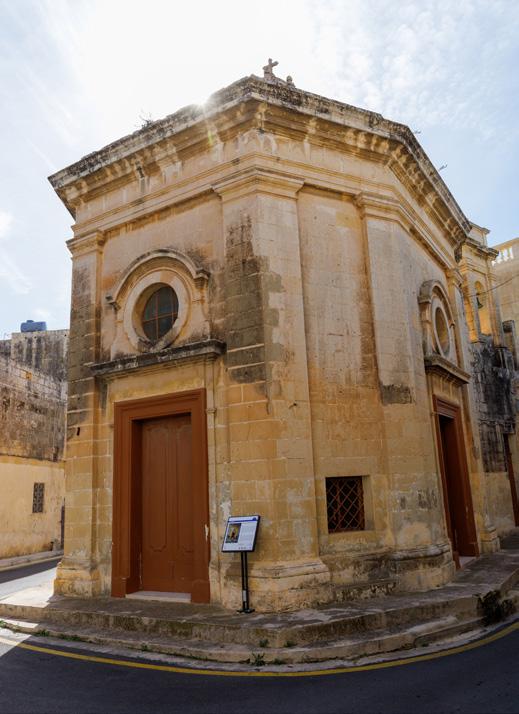


homeowners looking for properties that had withstood the test of time, had character and could also be adapted for modern lifestyles, creating an interesting blend between old and new.
Today, it also offers an array of tourist accommodation for those who prefer to be lodged in the smaller and more characteristic towns of Malta and away from the hustle and bustle.
The hub of social, cultural and commercial activity, similar to other town centres, remains its main square, with its prominent and dominating parish church dedicated to St Philip – the pride and joy of the Żebbuġin
A late Renaissance church, it is richly decorated in the baroque style. The original parish church, dating from the village’s origins, around the 1400s, still lies beneath. Besides offering daily Mass, the Parish Church of St Philp of Agira is the focal point during Easter, when thousands visit for a lavish and exciting procession, complete with a chariot to immerse its visitors in a bygone era.
And of course, no parish is without a celebration of its patron saint. But Żebbuġ has not just one feast, St Philip. It is also dedicated to St Joseph. Here, we get double the amount of fireworks throughout the year, as well as band marches and festivities. The colourful displays are unique and truly magnificent in the summer months.
Besides being the backdrop for Żebbuġ’s festas, the main square also provides a space for the social aspect of the town to come alive. Next to the church, without fail, and at all hours, one finds
groups of men, many of them retired, chatting about the day’s progress; discussing anything from the weather to football, family and politics. They know all the comings and goings!
Together with a lively market, selling food, vegetables and clothing, open on weekdays, it is the place to people-watch from the many cafés and restaurants in the area.
Music is also the focus in the heart of Żebbuġ, with one of Malta’s oldest band clubs located here. But this town is, indeed, special because we actually have three: St Philip Band Club (1851), St Joseph Club and De Rohan Band (1860) and 12th May Band and Social Club (1961).
While the fabric of the village core has changed somewhat along my years here, due to the ever-increasing housing demands, Żebbuġ has not been completely affected by modernisation, and there are concerted efforts by individuals, as well as through heritage signage, to inform its inhabitants and visitors about the town’s uniqueness in a bid to preserve as much of it as possible. And Ħaż-Żebbuġ, indeed, basks in a wealth of heritage.
Its narrow streets, as in days gone by, provide shade in the hot summer months and the perfect shelter from the north wind in winter. If you have time to visit, you will not only be able to enjoy some of Żebbuġ’s palazzos and old houses, as well as its rubble walls, but also the daily bustle of a truly Maltese town, which offers an immersive experience and a snapshot of the conflicts, achievements and glories of its past.
IL-BIZZILLA ZOOMS IN ON SOME IMPORTANT SITES IN Ż EBBU Ġ , OFFERING AN EASY GUIDE TO THE LOCALITY OF THE MONTH TO MAKE SURE YOU TICK ALL THE RIGHT BOXES ON YOUR VISIT.

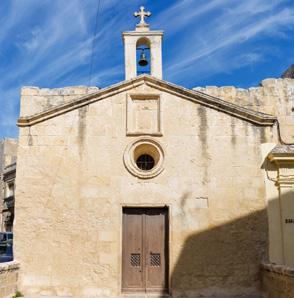
In this chapel, with its simple architectural structure, is a painting of St Roque above the main altar, an early 17th-century work by an unknown artist that was restored in 1989.

Also known as the New Gateway, this is a commemorative arch that was built in 1798 to honour the locality's status as a city, granted by Grand Master Emmanuel de Rohan-Polduc on 21st June 1777.
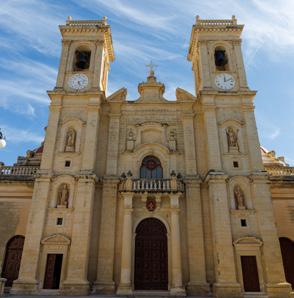
Built between 1599 and 1632, it was enlarged by the architect Tommaso Dingli in 1660 and modified in 1913 when the side aisles were added.
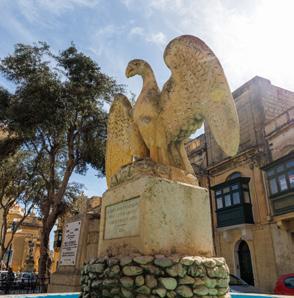
Located in front of the parish church, this was built in the mid-1850s when Żebbuġ was served with valley water through an underground aqueduct. The monument in Misraħ San Filep by Governor William Reid depicts his family’s coat of arms.

This is the narrowest road in Żebbuġ, as its name implies, and one of the prettiest too, just off the parish church.
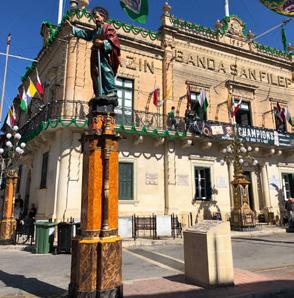
San Filep Band Club Association was set up in 1851 by Mro. Filippo Galea and is referred to as the mother of Maltese bands. The social club is located in the main square, Misraħ San Filep.
CLICHÉ
CATANIA IS TO MANY. BANISH
OF MARKETS AND MALLS AND DISCOVER THE SUBTLE BEAUTY OF SICILY’S MOST UNDERRATED CITY.
To the casual observer, Catania and elegance might not be immediately synonymous. And yet, beyond the memory of 1980’s bulk buying and cut-price shopping, La Milano del Sud , as it is proudly known by our Sicilian neighbours, is a true gem, waiting to be discovered.
Reborn multiple times of the Etna’s ashes, Catania is home to a vibrant, enterprising population that for centuries traded, built and decorated for posterity, gifting us their seaside city as a baroque opera set rising from the waters. Small enough to be conquered by even the least experienced traveller and a mere 40-minute flight away, Catania is far more than you might think.
Despite my family’s Catanese roots, I first visited Catania as an adult, oblivious to its subtle beauty and calmer demeanour when
compared to regal, chaotic Palermo. And yet, on my first night there, I felt like I belonged. The rhythm suited me, the December air was crisp but gentle; even my hair looked better than it did at home.
And just like my first trip to Catania, yours cannot but begin at Piazza Duomo: dominated by its legendary obelisk-topped elephant fountain, this scenic square is the historic heart of the city, flanked on three sides by palaces and churches and on its fourth by Catania’s major thoroughfare, Via Etnea.
Visit the Duomo di Sant’Agata and marvel at its baroque interior; the jewel-encrusted statue of the city’s patron saint is also a wonder to behold. Right beside the cathedral is the Fontana dell’Amenano, which leads to Catania’s fish market, one of Sicily’s
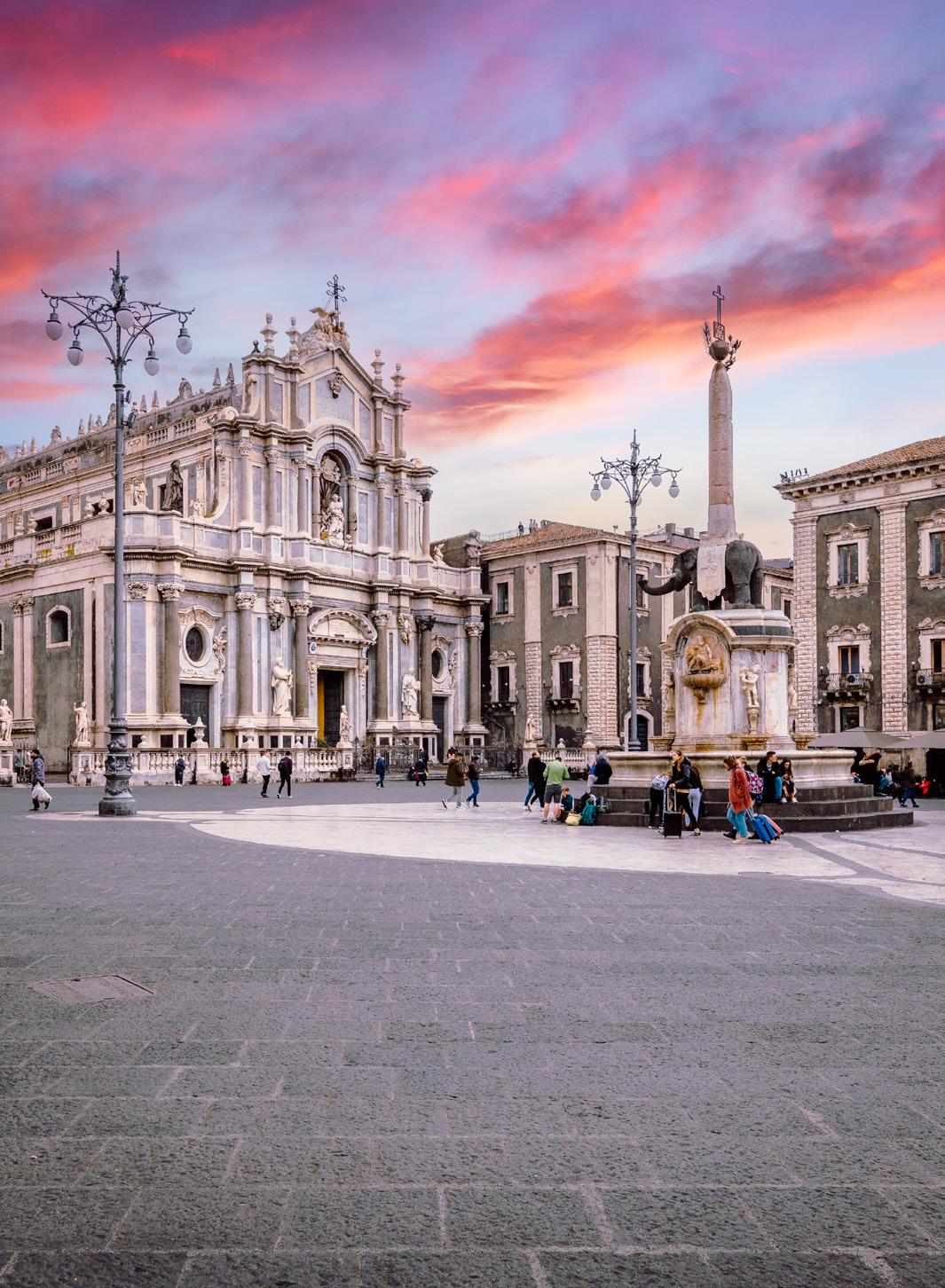
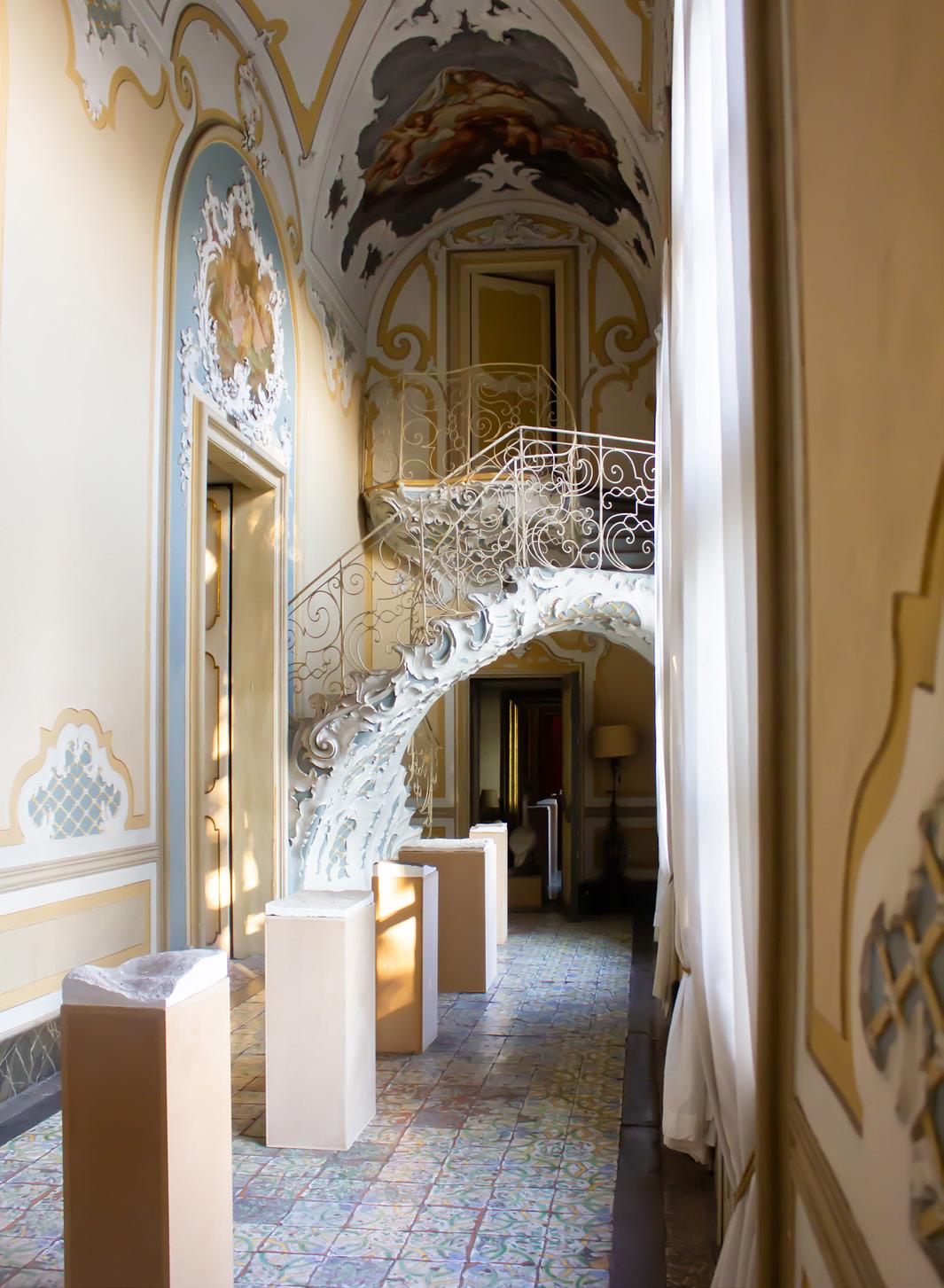

most vibrant and important after Palermo’s La Vucciria. Wander through the stalls and examine the catch. Taste the samples and don’t disdain the freshly caught seafood, served raw with just a squeeze of lemon; it tastes just like the Mediterranean.
Back in Piazza Duomo through Porta Uzeda, the Museo Diocesano hosts a marvellous collection of paintings, sculpture and ceremonial silverware, as well as Sant’Agata’s solid silver canopied dais, a miracle of the silversmith’s art. Entrance to the Museo also entitles you to a trip around the 4th-century Terme Achilliane, a beautifully preserved Roman bath complex discovered following the disastrous earthquake of 1693.
Piazza Duomo is also home to a number of cafés: grab a coffee and a cheeky pistachio pasta at Prestipino and take a leisurely walk up Via Etnea, taking in the shop windows and purchasing anything you might possibly think of.
An often-overlooked monument is the recently restored Palazzo Biscari, still home to the Prince of Biscari and a breathtaking example of Sicilian baroque. Reserve a tour and explore this historic home, frequented by Goethe and the Queen Mother,

starting with its monochrome façade, built of black lava rock, decorated with filigree-like white limestone sculpture.
Palazzo Biscari’s very Instagram-worthy ‘wave’ staircase is a wonder to behold: the seemingly Art Nouveau construction is in fact pure 18th-century Rococo folly, while the ballroom’s majolica floors and the solid marble bathroom are just swoon-worthy. The Prince often pops by to greet visitors; he might even offer you freshly baked bread if you’re lucky.
While Catania may look consistently baroque, its roots are far older than they may seem. Bang in the centre of this city is the GreekRoman Theatre, uncovered in the 18th century and adjacent to the smaller Odeon. It’s a living testament to Sicily’s important role as Ancient Greece’s largest colony and, much like the many other Greek monuments dotting Sicily, is in remarkably good condition. Open from Tuesday to Sunday and accessible through Via Vittorio Emanuele, it’s an excellent introduction to Sicily’s Greek past and certainly worth the visit.
Speaking of theatres, the Teatro Massimo Vincenzo Bellini is a must-see and offers tours from Tuesday to Saturday, as well as
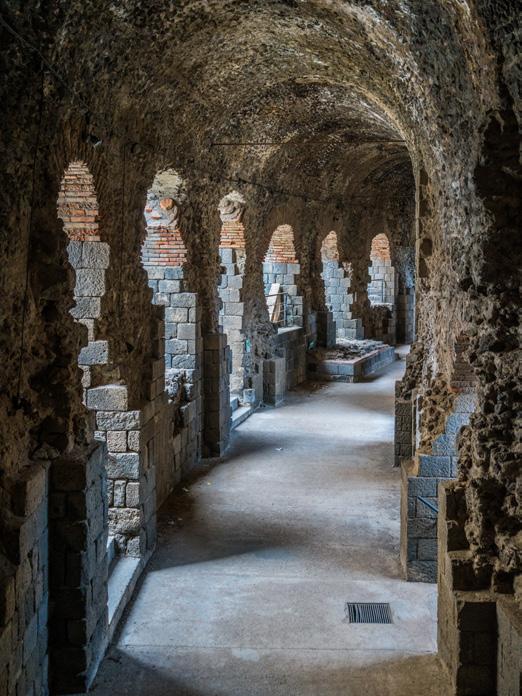


a varied programme, ranging from operas to shorter recitals. The Teatro Massimo hosted Bellini’s first Sicilian performance of Norma , an opera which, legend has it, also inspired one of Catania’s signature dishes, Pasta alla Norma .
Catania is also the perfect base from which to explore Sicily’s eastern coast, positioned halfway between charming Taormina and stunning Syracuse. Drive or catch a train to these beautiful cities and explore Taormina’s clifftop roads and Greek amphitheatre; sit in Ortigia’s main square and drink an espresso at Condorelli, while

Air Malta operates regular flights to Catania. www.airmalta.com
reading your favourite book. But most of all, steer clear of the cliché that Catania is to many of us: banish thoughts of markets and malls and discover Sicily’s most underrated city.
Michele Tufigno is the creative director of Studio Tufigno, a consultancy practice based in Valletta, and focused on interior decoration and arts curation within the spheres of publishing and contemporary art.





NEVER MIND CHRISTMAS. EASTER IS THE CATHOLIC CHURCH’S BIGGEST CELEBRATION AND MALTA EMBRACES IT WITH RELIGIOUS TRADITIONS AND CULTURAL CUSTOMS DATING BACK HUNDREDS OF YEARS.
“I have witnessed a miracle,” Dr Ivan Grixti begins. We are speaking just before Ash Wednesday, the first day of Lent, the 40day period of penitence traditionally observed by Catholics in the runup to Easter. While supermarkets everywhere count down to the spring holiday with an abundance of chocolate eggs and cute bunny motifs, the 360-plus churches in Malta take a more sombre approach to Easter, the biggest of the Catholic faith’s feasts.
It is impossible to separate Easter traditions from religion, although you don’t have to be religious to appreciate the centuries-old Lenten customs that peak during Holy Week, especially on Good Friday when the whole country seemingly goes into mourning for the death of Jesus Christ. Flags are flown halfmast, churches are stripped bare of their usual silverware, national radio stations tone down their playlist and thousands of devotees participate in or watch processions depicting scenes from the Bible and the Passion of Christ.
And it was during one such procession that Ivan says he experienced a true miracle of Easter. A senior university lecturer in accounts by day, he is a member of the Archconfraternity of the Blessed Sacrament, founded in 1575 at the Dominican Priory
in Valletta, and has been involved in church feasts and events all his life. For over 30 years, he carried statues in parish feasts all over the island, with a particular devotion for the Good Friday procession in Valletta.
“One Maundy Thursday, one of my colleagues told me he was worried about his ex-fiancée, who had tried to kill herself following the breakup of their relationship,” Ivan recalls. “She was in a coma in intensive care. I told him we just had to pray for her. The next day, as we were preparing to start carrying the statue of the crucifixion during the Good Friday procession, my eyes fell on the bloodied knees of the statue of Christ on the cross.
“I felt like a voice telling me to write the girl’s name on a paper and put it on the statue, and that is what I did. I tucked the small piece of paper under the foot of Christ, and we started the procession. During that entire procession, all my fellow statue bearers started complaining about the unusually excessive weight of the statue. It is a large statue – so large, it doesn’t even fit through the church door – and requires 10 men to lift it, but we had done it many times before. This year was different, however. It felt extraordinarily heavy; unbearably heavy,” Ivan recalls.

“Just as we reached the end of the procession, a couple of painful hours later, and we set the statue down to start dismantling it, my friend came running up to me with the news that his ex-fiancée had regained consciousn ess and would survive. It was a miracle!”
Such is the devotion that is the basis of Holy Week in Malta. The Good Friday processions may seem like an elaborate form of street theatre to the casual observer, but they are the culmination of weeks of preparation and a lifetime of dedication to the faith. Participants do not simply get involved for the love of costumes and pageantry, but they are primarily driven by a deep-rooted spiritual connection with their church.
“I always did it with a spiritual perspective,” says Ivan. “Not so many people realise that the Good Friday procession is a continuation of the liturgy of the Cross that has just ended in church. I always did it with great devotion. Yes, there is a part of it that, to us, is just another h obby, but Good Friday is the climax of our faith.”
For 45-year-old Gilbert Busuttil from Qormi, which hosts one of the largest Good Friday processions on the island, the procession is as
much about faith as it is tradition. “I am faithful to my faith. Deep down, I love the tradition part of it all, but there is still an element of spirituality in it,” he admits.
“When I played the part of Christ in the stage production of the Passion, I did feel it was not just playing any role; you’re playing the part of Christ. It’s a very important figure in the Church.”
Gilbert has been a keen participant in such events for as long as he can remember, and even used to involve his children from a young age. Since 2018, he was lucky to get a place as one of a band of six trumpeters and seven drummers, dressed as Roman soldiers and playing a fanfare in front of the statue of Christ the Redeemer.
Such is the popularity of the Good Friday procession in Qormi that participants have to be drawn by ballot, although musicians are harder to come by so Gilbert has pretty much secured his place for the foreseeable future. “We meet twice a week d own in the valley, where nobody can see us, to practice marching while drumming and playing the trumpets. We meet in all kinds of weather.”

The procession involves hundreds of people in period costumes representing biblical characters, plus between 10 and 12 statue bearers for each of the 14 statues.
“It starts at 5.30pm and takes one hour and 45 minutes for the whole procession to exit the church, around two hours for it to cover the two-kilometre route, walking very slowly through the town, and then a further one hour and 45 minutes for the procession to enter back into the church,” Gilbert highlights.
The procession has been organised in several towns and villages across Malta since the 16th century. But it is only in the past 10 years that the Qormi procession has included women in its narrative, albeit reserving only around 20 places for them as most of the characters are male.
Other towns feature a long list of biblical characters from both the Old and New Testaments, all wearing the most elaborate costumes, some of which are custom-made and proudly displayed by their private owners in glass cabinets during the rest of the year.
While Ivan confesses that Valletta struggles to find enough statue bearers due to the dwindling residential community within the capital and has to ‘ import ’ them from other towns, Qormi has a point system for statue bearers who have to earn their place and the privilege to carry a statue during the all-important Good Friday event.
“You have to earn your place by participating in about 35 to 40 smaller functions throughout the year,” explains Gilbert. “If you
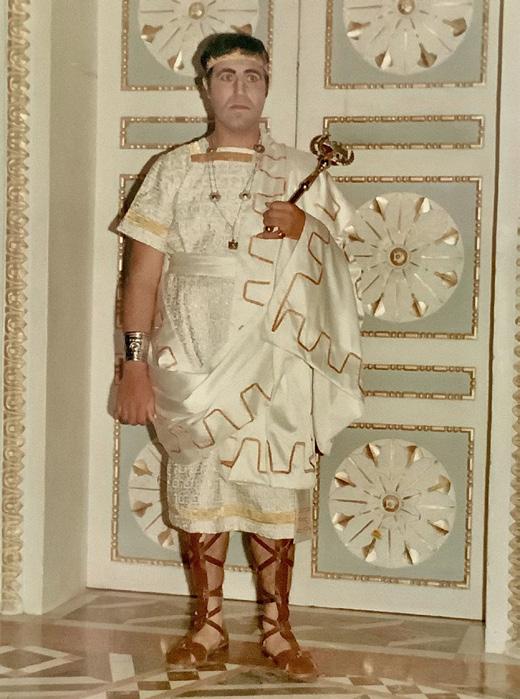
miss one, there is a big chance you won’t be able to carry a statue on Good Friday. Then, there are statues that are more prestigious than others to carry. This is all rooted in tradition,” he continues.
In t he town of Żebbuġ, which hosts one of the most famous processions, the place as a statue bearer, for example, is family-owned.
“Good Friday is more important than the festas ,” Gilbert points out. This is saying something as Malta’s summer parish feasts are legendary. But while those are a colourful cacophony of fireworks, brass band marches, lights and merriment, Good Friday’s sobriety goes to the heart of the spirituality of the day and has largely avoided any of the commercialisation of Christmas.
“In towns like Qormi and Żejtun, you really feel like something is different during Holy Week. In the days leading up to Good Friday, some people would be playing funeral marches at home,” Gilbert continues, adding that many set up mini exhibitions of their replica Good Friday statues in their houses.
The religious commemorations begin on the evening of Maundy Thursday. After that special Mass, during which the priest washes the feet of 12 parishioners representing the 12 apostles, devotees traditionally visit seven churches to pray, while others embark on the arduous walk up the hill above Siġġiewi to Laferla Cross, following an illuminated route dotted with decorated shrines.
Veteran actor Joe Quattromani, 81, remembers the early days of the now celebrated Mosta procession when taking part was “a
tradition” for the children, and most of the boys opted to walk it wearing chains around their ankles as a sign of devotion – and perhaps a little bravado too.
“In th e late 1960s, three friends and I suggested to the Church authorities to introduce grown-ups to dress up in robes personifying Pilate, Herod, Annas and Kaifas. I preferred Pontius Pilate. From a young age, I always had a beard, but I had to shave once a year for the procession. Of the four characters, only Pilate had no beard! I even had my own costume made especially for me,” Joe recalls.
“Th is experiment proved to be very popular. The following years, biblical characters, including Roman soldiers, increased in number, as did the participation of women in biblical costumes. The character of Pilate, which I chose to portray in the procession, happened after some advice and good thinking. According to our detailed script, my position during the Mosta procession is nearly halfway through, just in front of the Ecce Homo Statue.”
While Joe does not participate in the procession itself anymore, he is still involved in organising what has now grown into one of the largest processions. These attract thousands of onlookers, but many more watch them live on television.
Gilbert admits to feeling butterflies in his stomach as he exits the church midway through the procession. “Going out of the church, there is always quite a lot of excitement. This band of Roman soldiers is a new thing for the Qormi procession as it replaced the scouts, who used to play the fanfare on their bugles.
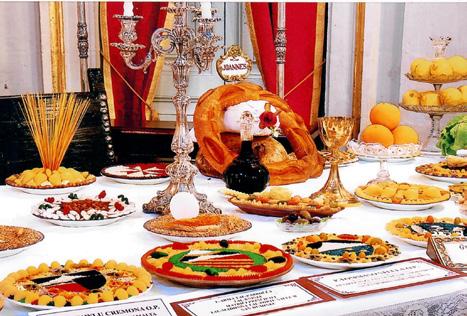
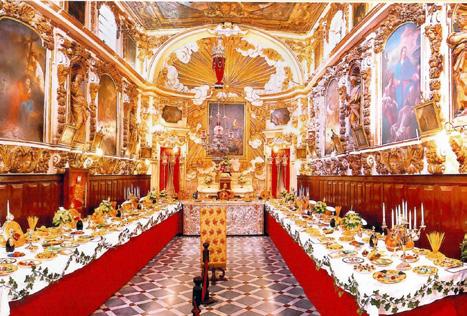
“The first time we did it, there were so many people watching us. We felt that excitement. There are always a lot of people around the church; then the crowds ease along the route. But the excitement sets in again as we head back inside the church at the end.
“You need to keep the rhythm throughout. Then I am in the zone. During the route I relax a bit, but I do feel the people’s eyes on me,” he recounts.
And while the procession is winding its way slowly and sombrely through the streets, inside the church, a small army of volunteers would be working against the clock to transform it once again from a place of mourning to one of celebration for the next day’s Resurrection Mass.
Friday ’s doom and gloom is lifted and the whole island erupts in a boisterous cheer of church bells and fireworks on the morning of Easter Sund ay, which this year, happens to coincide with Freedom Day.
And those lucky statue bearers will show off their prowess and skill as they run with the statue of the resurrection through the streets in the true spirit of a Maltese Easter.
Good Friday processions on 29th March will take place in Vittoriosa, Senglea, Cospicua, Luqa, Mosta, Naxxar, Paola, Qormi, Rabat, Valletta, Żebbuġ and Żejtun. All start between 5pm and 6pm.
Malta’s oldest Last Supper display returns this year for three days only at the Oratory of St Dominic’s Priory in Valletta. When it was first established 240 years ago, the food used in the display was distributed to 13 parishioners living in poverty. That charitable objective is still respected, and these days, the 60kg of raw rice and pasta used to make the elaborate, colourful plates are given to an NGO to distribute to the needy.
It takes eight volunteers, all members of the 450-year-old Archconfraternity of the Blessed Sacrament, the whole five weeks of Lent to meticulously prepare the 208 plates of coloured rice and pasta on site. The Last Supper is then further embellished with fresh Maltese bread, traditional Easter bread rings, olives, oranges and lemons as well as ‘fish’ crafted out of marzipan.
The display, which is blessed by the Apostolic Nuncio and is open for only three days, takes place inside the splendour of the 17thcentury oratory, considered to be one of the treasures of baroque architecture in Malta.
“It is a wonder within a wonder,” explains Dr Ivan Grixti, one of the members of the Archconfraternity, who will be on site to explain the history of the Last Supper display, open from 27th to 29th March. Entrance is free and donations are welcome.
DESPITE ITS DIMINUTIVE SIZE, THE MALTESE ARCHIPELAGO IS BURSTING WITH HISTORIC SITES, IDYLLIC SPOTS, CULTURE AND TRADITION. THE ISLANDS ARE LIKE NOWHERE ELSE. HERE, YOU’LL FIND FOSSIL-STUDDED GEO FORMATIONS, PREHISTORIC TEMPLES, INTRIGUING DIVING OPPORTUNITIES, AND A RICHLY WOVEN HISTORY OF REMARKABLE INTENSITY. FOLLOW THIS HANDY GUIDE TO WHAT TO LOOK OUT FOR DURING YOUR STAY.
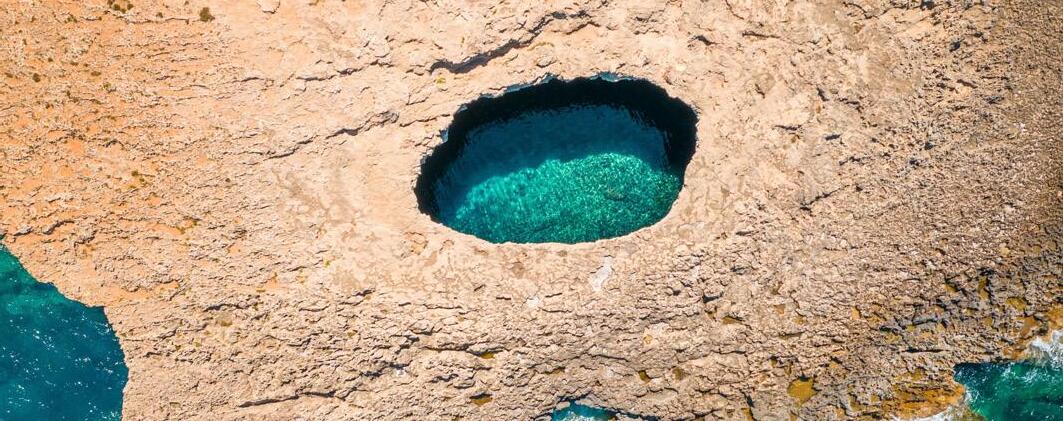
Venture off the beaten track to discover one of Malta’s natural wonders and best-kept secrets, located in the limits of L-Aħrax and Little Armier Bay.


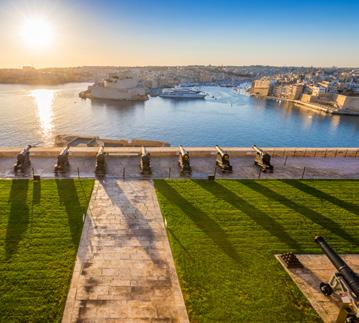
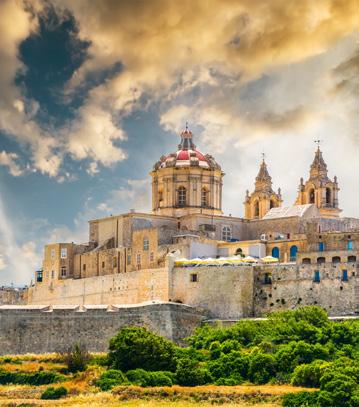
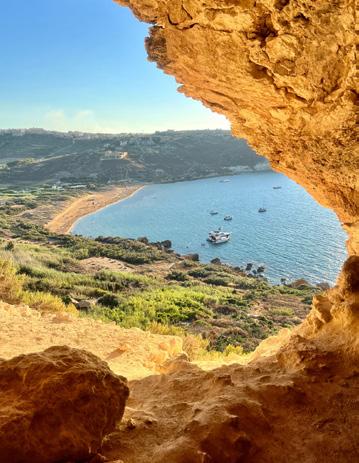
Diving in Malta is another way to immerse yourself in history. Many underwater wrecks, some placed strategically, remnants from the past, offer divers a whole new side to Malta and Gozo. Many registered schools offer trial lessons and rent equipment.
The Saluting Battery is a wonderful vantage point to view the Three Cities and Grand Harbour. These cannons are cared for by Wirt Ar tna , wh ich curates other properties and places of interest. They are fired daily.
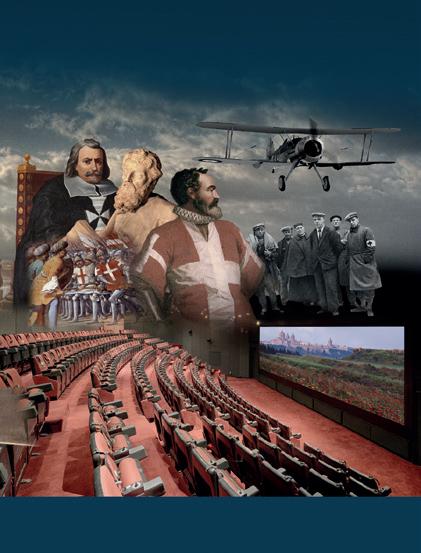

Interested in taking a journey through time? Mdina has it all – a long history, medieval and baroque architecture, and prestigious treasures that are part of Malta's cultural heritage.
This natural cave, located on the eastern side of Ramla Bay, is very commonly confused with Calypso's Cave, on the other side of the same bay. But both are worth a visit and offer a great Instagram shot!


CHECK OUT SOME IDEAS TO ENTERTAIN YOUR WHOLE FAMILY IN MALTA THIS MONTH. THERE'S SOMETHING FOR EVERYONE!

A Maltese heritage site, Is-Suq Tal-Belt is located in the heart of Valletta, the capital of Malta. Housing more than 15 food concepts under one roof, the original 19thcentury market hall has been renovated, while retaining the inside structure made out of iron – one of the first of its kind in Malta. So much more than just a place to buy food, it’s also a cultural hub, where people can meet and enjoy Valletta’s rich culinary heritage.

www.issuqtalbelt.com
suqtalbelt
suqtalbelt

Enjoy quality time and create lasting memories with your family at Malta’s popular children’s attraction, Playmobil FunPark. The indoor play area features Playmobil figures set in various scenarios, allowing children to unleash their imagination. In the outdoor area, kids can participate in exciting pirate role-playing scenarios on a ship and explore a treehouse. The FunPark shop sells the full range of Playmobil toys. Stay updated on Playmobil FunPark’s social media channels for festive announcements.

+356 2224 2445
www.playmobilmalta.com
funpark@playmobilmalta.com
NATURE IS ALWAYS THE STARTING POINT FOR ARTIST LEWIS ZAMMIT’S ABSTRACT PAINTINGS, AND THESE – LIKE HIS THOUGHT PROCESS – POSSESS MANY LAYERS.
Art educator Lewis Zammit is very much aware of the brevity of life, and how ‘small’ us human beings are when compared to the infinite universe and the questions surrounding the possibility of an alternate one.
This is where the title of his solo exhibition, Emerging Dimensions, stems from. In his new series of abstract paintings, Lewis plays around with the idea of the immensity of space, the unknown, and that humankind is a mere speck in this continuum.
While the exhibition is of abstract, non-representational art, Lewis, who lives and works in Mellieħa, constantly draws and paints from life and nature, keeping himself a breast with the basics of art, which any teacher and artist cannot do without.
All the exhibited paintings were executed in the last few months and years, and they are firmly linked to questions that preoccupy him. These thoughts are translated into his non-representational
paintings that depict his main preoccupation with space and the contradiction between this and form.
“There are times when space is form and form is space; any form is part of space, and space can be any form,” he says.
Despite this thought process, Lewis’s inspiration always stems from nature. He is one to enjoy being immersed in it, surrounded by the sea and trees, away from other people and enjoying the serenity that the natural environment provides. He also often observes how nature transforms itself.
In his studio are, in fact, objects such as corpses of a cicada or a chameleon that Lewis found in nature and picked up because of his interest in the patterns of their many skin layers and tones. He has even gilded these to give them a new dimension, showing how something so smal l and perhaps unnoticeable can be given another meaning.

Emerging Dimensions

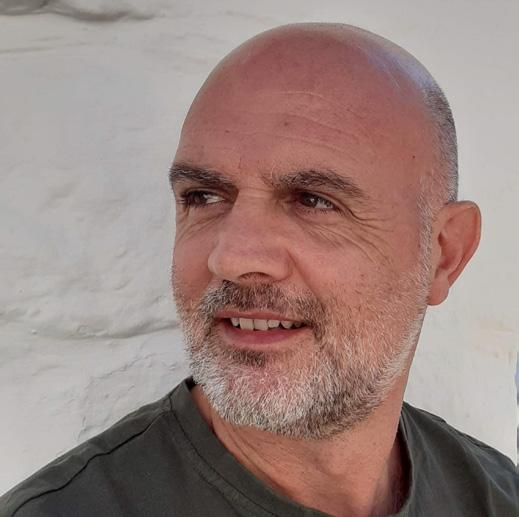
The solidity that the priming texture provides versus the fluidity of other sections is another quandary that Lewis tries to come to terms with.
Lewis is certainly an observer of his surroundings and quietly contemplates them. Eventually, these forms reverberate in his subconscious and find their way into his compositions. Nature is always the starting point for Lewis’s paintings, and these – like his thought process – possess many layers.
His works are executed in oil on board, which he primes himself, intentionally adding a lot of texture to the support. This will, at times, provide a rough surface, but at others, the composition is smooth and gleaming, while some paintings have a mix of both these techniques. The layers in his paintings are not just of oil glazes, but also of more solid materials.
The solidity that the priming texture provides versus the fluidity of other sections is another quandary that Lewis tries to come to terms with, and it goes hand in hand with the duality of space and form that he also contemplates.
The flowing layers present the opposite of the more solid aspects of his compositions, while undulating forms in these paintings, which ebb and flow across the surface, can also be noticed. The sfumato technique is also often employed between the boundary of the two, blurring it and creating a sense of vagueness.
Lewis’s palette has a predominance of earthy and cold tones, particularly blue and purple. Light is another important element in his art, with contrasts being adequately created, further emphasising the difference between form and space.
Lewis paints for his own satisfaction, and fundamentally, for himself. This can be seen in the gap between each of his solo exhibitions, this being his fifth show, held eight years after his last.
Lewis has also practised anamorphic art in Mellieħa, a public type of art that requires him to work with distortions to achieve the desired perspective. Whatever the case, nothing is arbitrary in the artist’s works, and they are executed after a lot of thought and meditation.
"Art is a means of communication by which souls meet across gaps of space and time,” says the artist, who lets his paintings speak for themselves and be interpreted by every individual.
Emerging Dimensions is curated by Dr Charlene Vella and is open throughout the month of March at the Palm Court Lounge, The Phoenicia Malta, The Mall, Floriana.
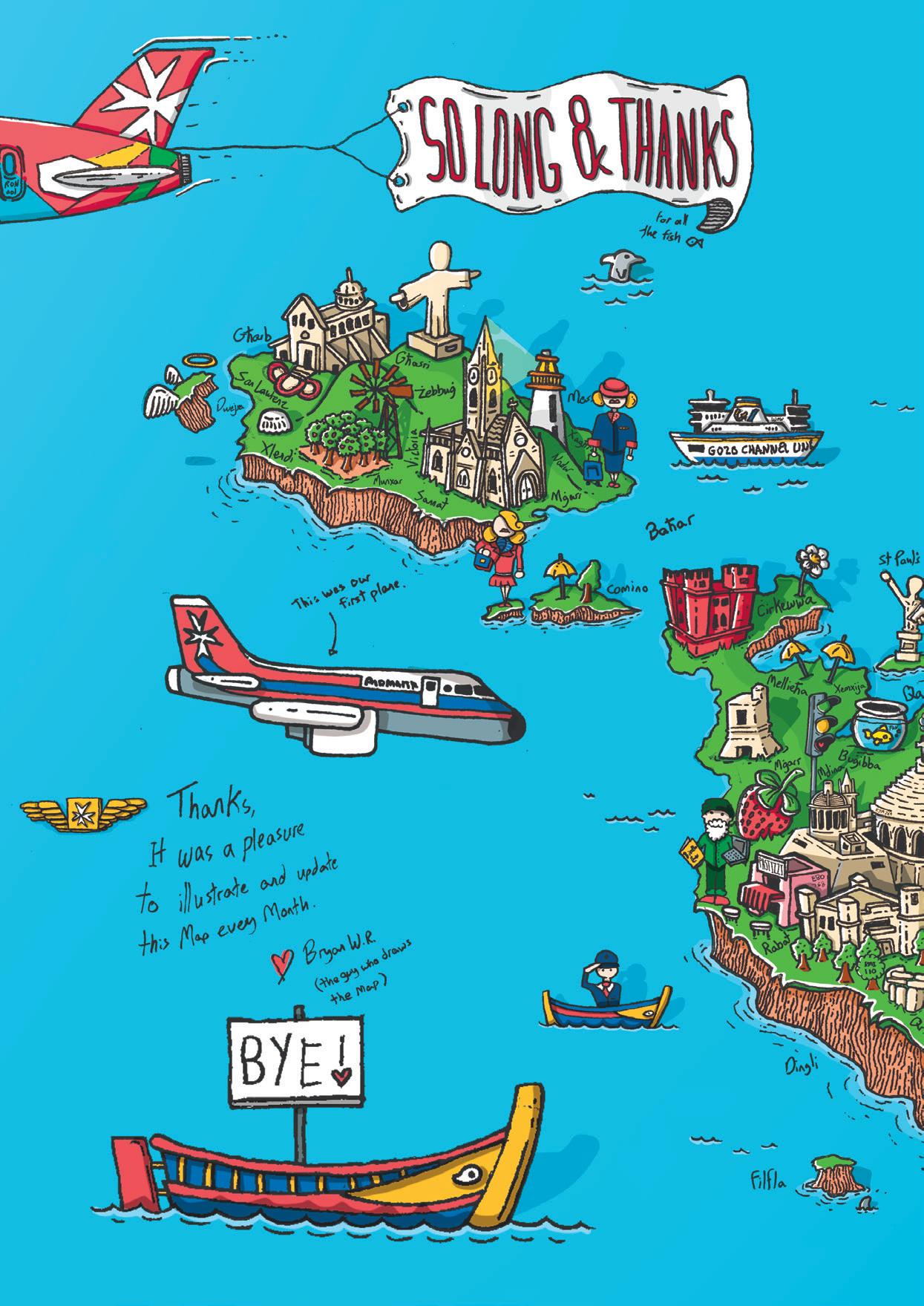


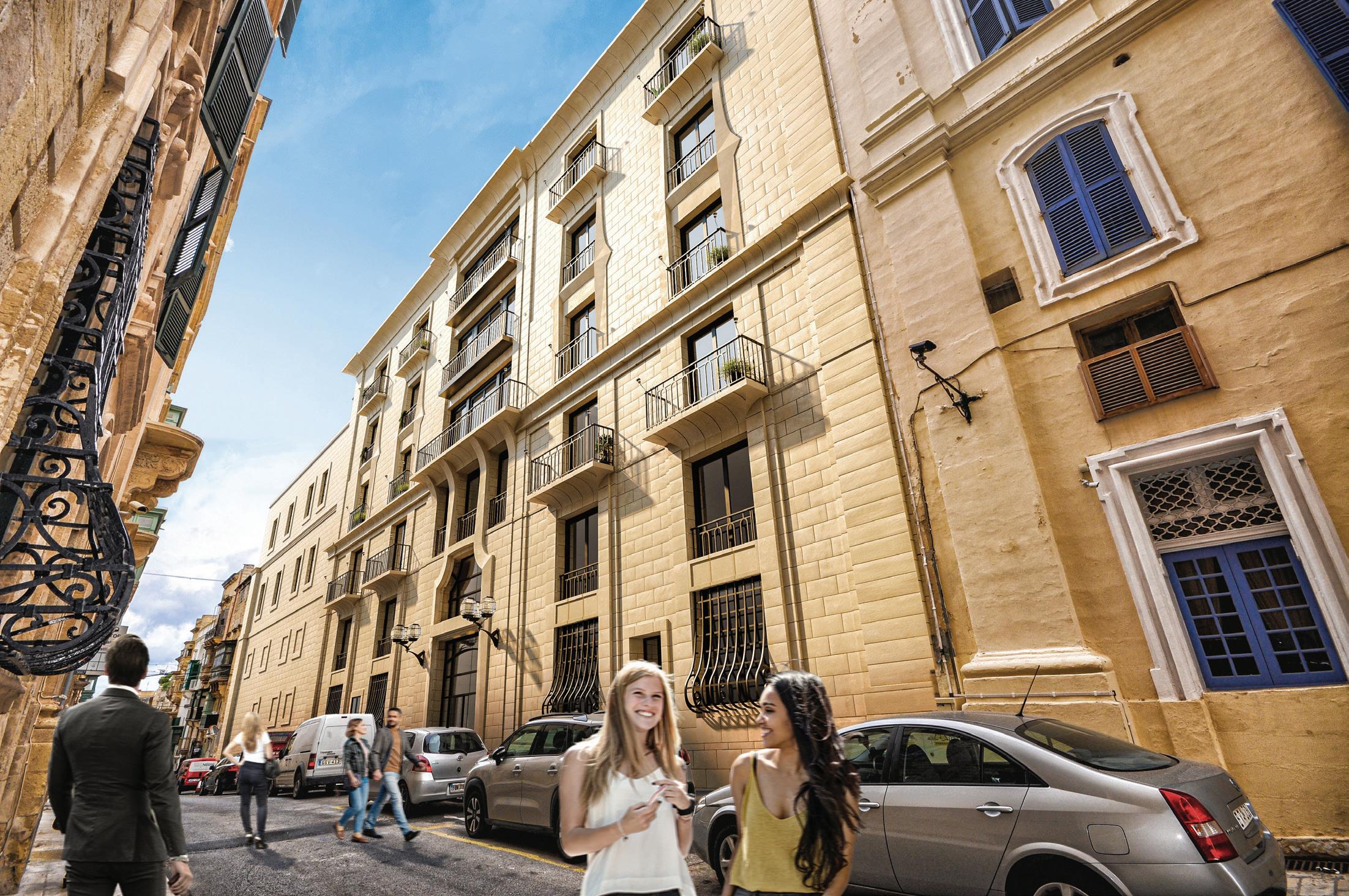
Strickland House offers Valletta’s only new build residences. A luxurious collection of 36 apartments and 1 townhouse with underground parking for sale in the heart of Malta’s capital city.



WHAT FUELS RIDERS’ DEEP PASSION FOR VINTAGE MOTORCYCLES? AS WITH MOST THINGS IN LIFE, IT’S NOT ABOUT THE DESTINATION BUT THE JOURNEY. AND RIDING IT OUT ON ONE OF THESE MECHANICAL MARVELS IS AN ART IN ITSELF.
There is a secret scent in the air that calls out to a motorcyclist’s heart. Whether it’s the clear blue skies, an overcast one that promises no rainfall, or a balmy summer breeze, something signals motorcyclists that it is time to put on their helmet and gear and go for a drive. They hit the Maltese roads in a manner that can best be described by the Italians as ‘dolce far niente ’, or the pleasant idleness of doing nothing.
Lovers of vintage motorcycles also take a trip down memory lane each time they hit the tarmac. There are around 500 registered vintage motorcycles in Malta, turning heads... and some turning over engines that are almost a century old.
“The term vintage motorcycle refers specifically to a particular period in time, ranging from 1914 to 1930. But then you also have veteran motorcycles, dating from 1900 to 1914; post-vintage, spanning the years from 1931 to 1939; and classic motorcycles going from 1940 to circa 1970,” explains Albert Pisani, founding secretary of the Historic Motorcycle Club Malta.
Modern motorcycles cover the period from 1971 to around 1985, but then many today refer to a "classic" as being any iconic model, whether from the early 1940s or present day. Models produced during the war years, 1914 to 1918 and 1939 to 1945, vintage or classic, are usually simply referred to as military motorcycles.
“Also, one has to bear in mind that most of the preserved models on the island are British-made, because of the long association as a former colony for 150 years. Having said that, there is also a smattering of Italian, German and American motorcycles. And a pretty large number of Japanese dating from around 1975 to date,” Albert adds.
Malta is home to some unique motorcycles, especially because all vintage models were built in an era when things did not have a shelf life and were made to last. The 1920s and the 1930s were years of innovation, and mo torcycle manufacturers started moving away from their original ideas to a more complete and purpose-made machine.
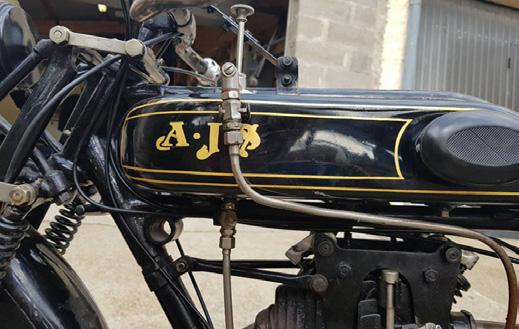

But Pisani notes there are only a few left on the island because owners let rust take over after abandoning the motorcycles for a more modern and efficient vehicle.
“Notwithstanding, one still finds Nortons, AJSs, Royal Enfields, Raleighs, BSAs, Triumphs etc... from the vinta ge period on the island, with exposed valves, three-speed hand-change gearboxes and acetylene gas lighting,” he points out.
But what fuels the riders’ deep passion for vintage motorcycles?
“There are many reasons why one could be attracted to motorcycles of a bygone era not ,just the vintage period. The older among us would say it’s because it reminds them of their youth and carefree days. Classics of the 1950s and 1960s are all the rage at the moment for that reason”, Albert says.
Some are drawn by the simplicity and ease of repair of their engineering make-up, while others venerate the war relic and all the war-imposed designs of each model. “I prefer the early models from the veteran or vintage period because most of the technology that produced them would appear alien in this day and age and also because it takes skill to ride these mechanical marvels,” Albert adds.
Indeed, starting a vintage motorcycle is an art in itself. The rider is in full control of the workings of the machine, unlike a modern motorcycle or car engine, which comes to life at the touch of a button, or the turn of a key. Not so on a veteran/vintage motorcycle: “One has to ease the piston over compression and, after having balanced ignition timing, and carburation, one gives an almighty heave on a small 12-inch lever, termed a Kickstarter, and the engine bursts into life, hopefully!”

But it doesn't stop there. Once you get going, then you need to pump the oil into the engine every five or so miles, advance or retard the ignition depending on the conditions of the road, and balance air and petrol levers on the handlebars to ensure the best possible mixture of fuel entering the motor. Then sail along to the sound reminiscent of a treadle sewing machine.
Learning how to master a beast from the past could be the secret to a m otorcyclist’s love for the vintage model. “The passion, to a greater or lesser degree, could be just this: the ability to ride such an anachronistic vehicle or possibly the challenge experienced when restoring su ch a vehicle from a load of rusty bits that had languished in a box in a damp garage corner for years,” Albert explains.
Although most vintage items are carefully preserved to help with their longevity, this is not the case with motorcycles. In fact, the motto of the Historic Motorcycle Club is "ride them, don't hide them". Even though riding your vintage motorcycle to work might not be the best way to keep it running, Albert says the club members enjoy riding them abroad to overseas rallies and events.
“Motorcycles were made to be ridden,” Albert continues. “Of course, there are challenges nowadays, with the volume of traffic on our roads, but usually, especially when riding with the club, there is a lot of respect from other road users and one is given the space one needs,”.
The Historic Motorcycle Club Malta holds an annual exhibition and meets every Saturday at 2pm at the Msida Marina Gardens.

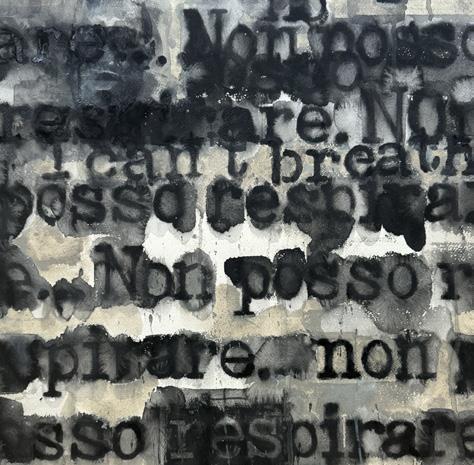
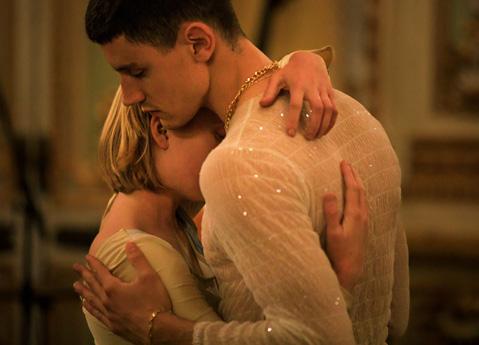
VENUE:
Concert Hall of the Malta Society of Arts, Palazzo de La Salle, 219, Republic Street, Valletta
DATE:
2nd March 2024
ONLINE:
https://artsmalta.org/event/operatic-concert-maltese-bulgarian-music-legacy/ The Maltese-Bulgarian Circle is organising a concert of vocal classical music to commemorate the day of the Liberation of Bulgaria from the Ottoman rule, celebrated on 3rd March. Maltese, Bulgarian and European talent participating in this event includes the Bulgarian-born Maltese soprano Andriana Yordanova, the Maltese baritone James Agius and the young Bulgarian bass Deyan Kostadinov. The singers will be accompanied on the piano by Sofia Sciberras-Narmania.
VENUE:
Christine X Art Gallery, Tigne Street (c/w Hughes Hallet Street), Sliema
DATE: 7th to 28th March 2024
OPENING HOURS:
Monday to Saturday: 10am - 1pm and 4 - 7pm
ONLINE: www.christinexart.com info@christinexart.com
CONTACT:
+356 9984 4653
This thought-provoking solo exhibition by Svetislav Martinovic invites viewers on a profound journey, encouraging introspection and sparking conversations on the interconnected themes of brutality, environmental consequences and societal challenges. Through his art, Martinovic skilfully intertwines these complex narratives, exploring a shared sense of suffocation in a society grappling with multiple challenges.
VENUE:
Gran Salon, Archeological Museum, Valletta
DATE:
15th and 16th March 2024
ONLINE: zfinmalta.org
info.zm@zfinmalta.mt
TICKETS:
Showshappening
Intimate Żfin unfolds through a series of dance sketches, creating a dialogue between the choreography, music and architecture, and performed live in the space with Alexandra Alden and her band.
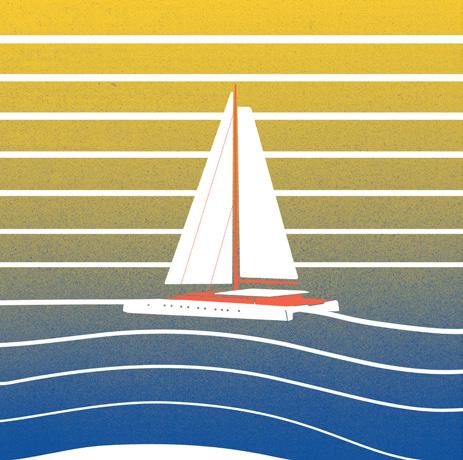
VENUE:
Xatt Pinto, Valletta Waterfront
DATE: 21st to 31st March 2024
ONLINE: www.kreattivita.org @spazjukreattiv
Spazju Kreattiv, Malta’s National Centre for Creativity, in collaboration with Art Explora Foundation, will inaugurate the Art Explora Festival this month, marking the beginning of an extraordinary maritime journey across the Mediterranean, with Malta being the first of a series of captivating stops. With a line-up featuring more than 30 initiatives and 55 activities, with local and international artists and NGOs, the festival addresses a variety of urgent socio-political concerns, including environmental sustainability, social justice and personal well-being.
Free of charge (booking required).


Whether you’re a regular at The Point Shopping Mall, or visiting for the first time, you must pop into Mavenry. Offering an eclectic selection of over 75 streetwear, upscale and avant-garde brands from around the world, including Karl Lagerfeld, Marc Jacobs, Diesel, Kenzo, Varley and many more, Mavenry will certainly fulfill your dream of a unique and personalised shopping experience.
The Point is conveniently located in the heart of Sliema, one of the island’s main hubs for locals and tourists alike, and offers a dynamic mix of the latest fashion, beauty, health and lifestyle stores for all its visitors to enjoy.
Home to well over 150 brands under one roof, it houses an eclectic range, from beloved international names to more exclusive ones, not to mention some local brands too. Fashion outlets at The Point know no age as you can find gorgeous pieces starting from newborn sizes all the way up.
And it’s not just about fashion either. Technology, homeware, entertainment and many more outlets can also be found, giving shoppers an incredible variety to choose from, be it for themselves, or even as souvenirs or gifts for loved ones back home.
Of course, there’s more to The Point than shopping too, thanks to its awesome selection of eateries that cater for all palates and lifestyles. Smoothies and salads, sandwiches, wraps and yummy bakes, pizzas, pasta and burgers, pancakes and milkshakes – all of these and more can be found at The Point!
So, whether you’re in the mood for a great filling meal, or a quick snack to keep you going while you shop (healthy or not so much), you’re sure to satisfy your cravings!
Aside from offering such a fantastically versatile shopping experience for people of all ages, lifestyles and budgets, there are many other factors that give this mall its unique status as Malta’s retail jewel in the crown – and these includes its location and history.
The Point Shopping Mall is located mere metres from Tigné Point, a small peninsula that played a big part in Malta’s history, including the Great Siege back in 1565 and the British Rule from 1800 to 1964. In fact, the mall itself was built on the site where the former Tigné Barracks were located, and the remaining architectural structures in the form of arches that run along the mall and the square can be appreciated.
Tigné Point overlooks the stunning Valletta waterfront, which is one of the island’s most iconic skylines. So, if you’re fascinated by the history of the area, or on a hunt for breathtaking views, you’re sure to be mesmerised by your visit to The Point.
This is the perfect place to combine a love for shopping, food, gorgeous views, perfect for that #holidaymode selfie, and a great time. The mall is also fully air-conditioned, ticking all the boxes for the ultimate fun day out. It’s a definite must on your to-do list during your stay in Malta.
Opening hours:
Monday to Saturday, 10am - 7:30pm; and Sundays, 11am - 6pm.

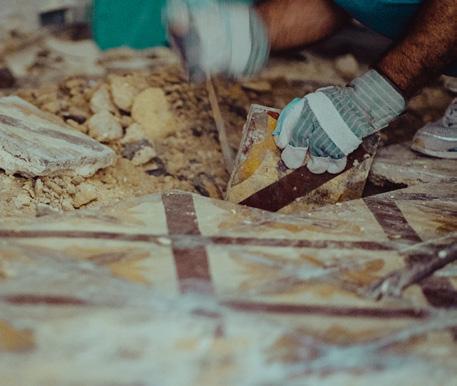
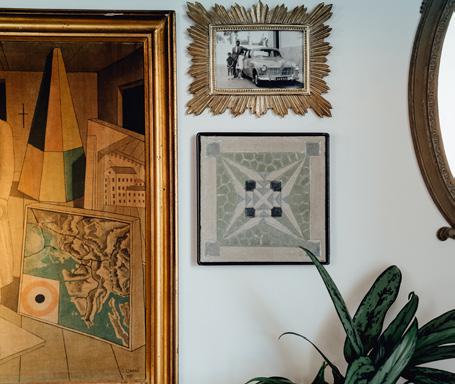



WORDS MALTA MARITIME MUSEUM
READ BETWEEN THE LINES AT THIS MALTA MARITIME MUSEUM EXHIBITION TO UNCOVER AND EXPLORE THE ISLAND’S DEEP AND HISTORICAL CONNECTION TO ITS ONLY NEIGHBOUR – THE SEA THAT HUGS IT.
When looked at from outerspace, planet Earth is often described as a big blue pearl, serenely suspended in the cosmos’s black canvas. Those azure oceans and seas filling in the gaps between the continents’ vast and rugged landscapes have been key in the shaping of today’s world, enabling the forging of connections between humans and cultures from every corner of the globe throughout history.
Malta, as an island nation in an outstandingly strategic location, with its destiny ebbing and flowing to the rhythm of the waves battering its shores, can be viewed as a microcosm in this regard. Its people have ventured beyond these shores, turning their biggest natural barrier into a bridge – one that has delivered to the island war, famine, riches and prosperity, creating in the process ‘an island at the crossroads’.
Such is the title of a new exhibition at the Malta Maritime Museum, housed within the iconic Old Naval Bakery building, peacefully nestled on the beautiful Vittor iosa waterfront. The outcome of curators past and present, the exhibition includes an astounding collection of poignant historical items, and reads between the lines to uncover Malta’s deep and historical connection to the sea that hugs it.
The Malta Maritime Museum’s doors have been closed to the public since 2020 as it is undergoing a major rehaul. The initial phase, partly financed through the EEA Norway Grants 2014-2021 and totalling €2 million, saw the regeneration of the dilapidated and unutilised areas of the building and the setting up of a Digitisation
Unit with a Collection Management System to digitise the Maltese Islands’ maritime heritage.
An Island at a Crossroads offers a unique opportunity to step once more into this museum, while its transformation is still unfolding. The artefacts on exhibit make up 20 themes, revealing a tapestry of sea-sprayed tales that have moulded the Malta we know today. An alluring pottery fragment with incisions of a solar wheel, sourced from Ħaġar Qim, sets the timeline deep into Malta’s prehistory, and highlights the shared and unchanged human need for direction.
The Phoenician seafarer, the British submarine commander and the refugee have very little in common at first glance, barring their accompanying navigation instruments, partners in their search for prosperity, prize, or even merely life.
A rare, near-complete brass nocturnal with which, centuries ago, seafarers guessed the time at night by observing the position of the stars is another (literally) stellar artifact gracing the showcases.
A Roman anchor lead stock, with the names of the GrecoEgyptian gods Isis and Sarapis embossed on one of its sides, takes us straight into ancient times, when Malta was already a thriving sea-trade hub. This is thought to be the anchor of the vessel that was shipwrecked off the islan d in 60 AD. One of the survivors of that shipwreck was St Paul of Tarsus, who spent his time on the island preaching the faith and converting the islanders to Christianity.


A curious marble column, originally Roman, used as a funerary ornament by the Arabs, then perched in Grand Master Lascaris’s belvedere in honour of an Italian knight, physically narrates the story of a shape-shifting nation, as different rulers sought to dominate its strategic location.
An ex-voto painting, probably the oldest one known on the island, depicting the Madonna della Flotta overseeing the famed Battle of Lepanto, and a set of bronze guns, transport visitors into the cutthroat, polarised world of the early modern Mediterranean, when corsairs – Christian and Muslim – ravaged its shores on a daily basis.
The whirlwind of change set about by the Napoleonic era is ushered in the picture with an original letter signed by the young general instructing General Louis Desaix to set his sails towards Malta. Even in wartime, however, Cupid’s touch does not fail to make an appearance, as evidenced in the exquisite Rococo bed shared between Lady Hamilton and Admiral Horatio Nelson.
A late 19th-cetury travel booklet penned by two British sisters vacationing in the island; a symbol-studded Jolly Roger, flown by HMS Safari – one of the most successful submarines operating from Malta during World War II; and frills and frocks are but a few of the artefacts covering the British era that followed.

The smell of freshly caught fish and the notoriously loud fishermen’s street cries fill visitors’ imagination as they face a pair of fishermen weighing scales alongside other equipment of these folk, and a traditional 19th-century firilla boat.
Immersi ve audiovisuals and set-ups offer a unique trip to Malta’s Dockyard – an indu stry that grew to be indispensible, becoming the bread an d butter for thousands of locals and their families for decades.
Sever al activities will be taking place each month in conjunction with this exhibition, including intriguing talks by ex-Dockyard workers, mind-opening conferences, sumptuous Taste History events, and even an op po rtunity to spend a night at the museum.
Now it’s up to you to drop by and have a merry time at the Maritime! Listen to the stories, both beautiful and terrible, and you’ll find yourself at a crossroads, much like this sweet island, to fathom from where we departed and envisage where we’re headed.
Visit www.maltamaritimemuseum.mt for more information.

Spring in Gozo is bewitching; the countryside’s fresh awakening is captivating. And if you are visiting in the second half of March, your holiday will coincide with Holy Week and Easter celebrations – the bonus of a spring holiday as there are so many things to do at this time of the year.
Easter in Gozo is a special time, with many facets, most of which are connected to the passion and resurrection of Jesus Christ. The biggest Catholic celebrations on the islands, they start a week before Good Friday, when Gozo dons a sombre outlook – fitting reverence for the procession of Our Lady of Sorrows that takes place in Victoria and several other villages.
Next comes the jubilation on Palm Sunday, reminiscent of Jesus’s entry into Jerusalem. The crowd of faithful, carrying palm fronds and olive branches, is led by priests robed in red.
Palm Sunday signals the beginning of Holy Week in Gozo – a week that commands the utmost devotion from the faithful as the Catholic Church marks Maundy Thursday and Good Friday. Typically, believers will flock to the liturgical services on these days. On Maundy Thursday, the churches are usually open till late at night. This is a perfect time to wander around Victoria and visit them and their artistic representation of Christ’s sepulchre, complete with flower displays and fragrant with balm and incense.
These solemn days of Holy Week in Gozo are marked by many religious exhibitions, sacred concerts, pageants and processions. Witness the deep-rooted devotion of the procession participants, who hide their identity under full-head hoods as they haul heavy ankle chains in penitence or as ex-voto. Experience the flickering candlelight displays on various church parvises on Maundy Thursday, offering a particular ambience to the night.
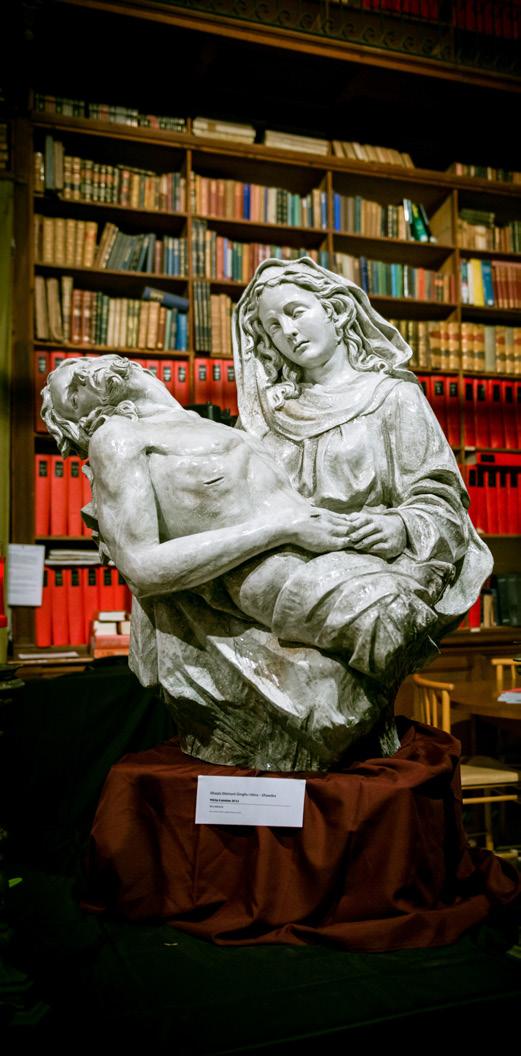
Holy Week and Easter in Gozo cannot be complete without trudging up Għammar Hill, following t he white Carrara marble statues representing the Stations of the Cross. This hike can be experienced as a moment of persona l reflection or meditation for both believers and non-believers.
But Easter traditions in Gozo are not all about dark overtones. They have a colourful culinary aspect too. During Lent, it is mostly about fasting, abstinence and penance, and you may want to try out the frugal, non-meat dishes, like artichokes


stuffed with tuna, olives, garlic and capers, or grab a tuna, spinach and anchovy pie, known as qassatat , for a quick bite. Intended to be semi-sweet, kwareżimal , hot cross buns and the Apostle’s rings are the sugary treats of the season.
Then, the Saturday night Easter vigil service shatters the gloomy tone and, once again, it’s Easter in Gozo! As the jubilant Church celebrates the resurrection with processions of the Risen Christ on Easter Sunday morning, make sure you get hold of the traditional Easter figolli from artisanal bakers. Made of sweet pastry and loaded
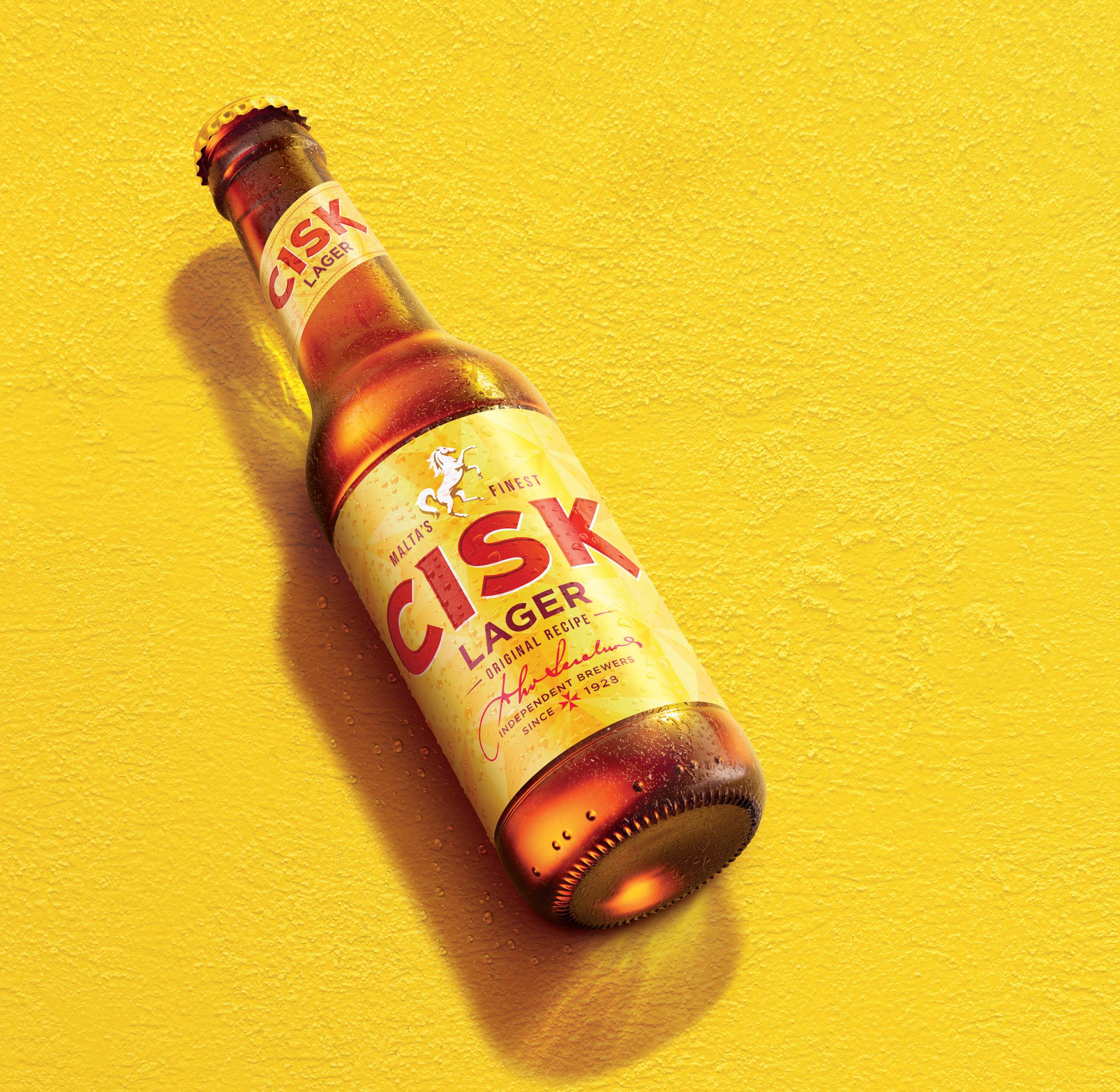
 WORDS SPAZJU KREATTIV
WORDS SPAZJU KREATTIV
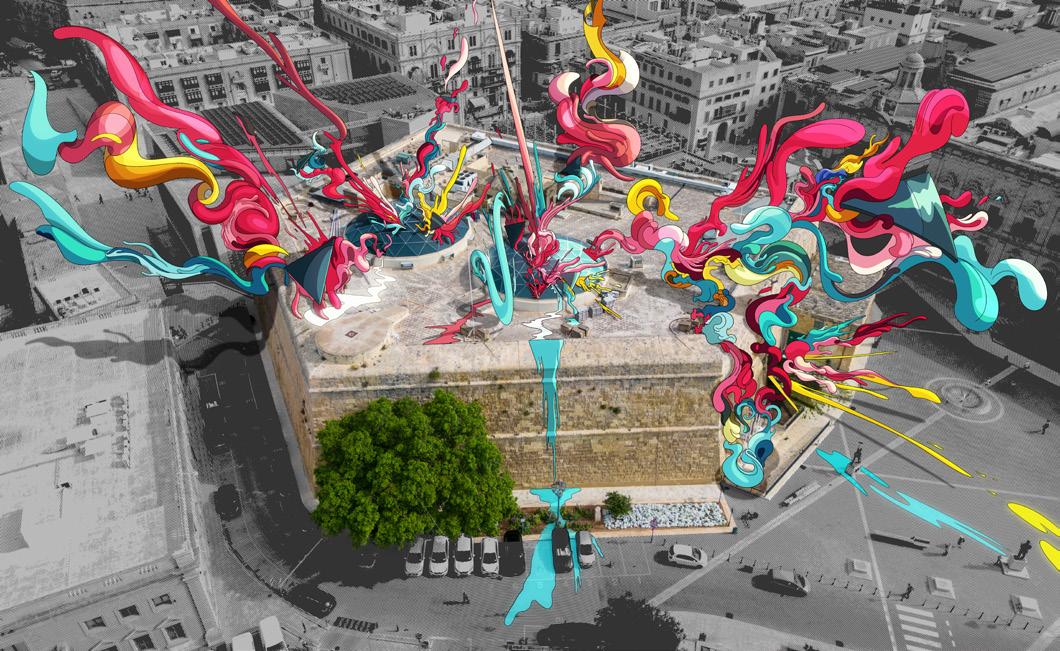
SPAZJU KREATTIV THIS MARCH HAS A MYRIAD OF EVENTS THAT WILL SURELY PIQUE YOUR INTEREST. WITH VISUAL ARTS EXHIBITIONS, THEATRE PERFORMANCES AND MALTA’S ONLY ARTHOUSE CINEMA, INJECT SOME ARTS AND CULTURE INTO YOUR STAY BY VISITING MALTA’S NATIONAL CENTRE FOR CREATIVITY.
This month, Spazju Kreattiv’s visual arts exhibitions include Anne Immelé's immersive project, Melita, −mlţ , refuge, intertwining Malta's historical richness with contemporary migratory struggles, using photography to articulate the timeless essence of Phoenician sites and the fleeting lives of sub-Saharan refugees.
In parallel, the interdisciplinary exhibition DREAM [of] LAND explores the nexus of identity, belonging and home through art and craft as it challenges the significance of matter, urging viewers to rethink their relationship with time and land.
In contrast, Her Say – Not Hearsay is a powerful theatre project as it delves into pivotal moments in women's lives, addressing redundancy in 1945, menopause and domestic violence. The narratives unfold with historical depth, humour and chilling
realism, exploring the profound intersections of history, personal growth and societal challenges.
During Easter, Spazju Kreattiv, in collaboration with Art Explora Foundation, will inaugurate the Art Explora Festival in Malta, taking place from 21st to 31st March, happening at Xatt Pinto, Valletta Waterfront. The festival unites local and international artists, NGOs and intellectuals to explore urgent socio-political issues through 30 initiatives and 55 activities.
Free of charge, this innovative festival offers cultural experiences, addressing concerns such as environmental sustainability, social justice and personal well-being.
Visit www.kreattivita.org for more information

 WORDS MALTABIENNALE.ART
WORDS MALTABIENNALE.ART
MALTABIENNALE.ART,
This spring, Malta is making its debut in the international biennale scene, with its first contemporary art biennale opening its doors on 13th March and running until 31st May.
Nestled within the islands' UNESCO World Heritage Sites, which range from the prehistoric to the baroque, maltabiennale.art will feature new and emerging artists from all around the globe as they come together to explore the biennale's thought-provoking themes on modern Mediterranean identity.
Malta's inaugural international contemporary art biennale is a feast for the senses. Its overarching theme, Baħar abjad imsaġar tażżebbuġ (white sea olive groves), instantly evokes the inherent scent of the Mediterranean.
Coinciding with the arrival of spring and the corresponding Easter festivities, maltabiennale.art in troduces visitors to the joy and aesthetic beauty of Malta's festa season.
A fusion of the historical and the contemporary, the first biennale will have its main pavilions in various locations around the islands, including the newly restored Grand Master’s Palace in Valletta and other sites in the capital, as well as in Cottonera and the Ġgantija Archaeological Park in Gozo.
It will be complemented by national pavilions and individual exhibits spread across other heritage sites, which will be far from mere backdrops; their presence and historic significance playing a vital role in the understanding and overall experience the biennale seeks to present.
As audiences make their way through the biennale's various locations, four artistic themes unfold: the Mediterranean as a political body; the Matri-archive; the counterpower of piracy; and
post-colonialism. Under these themes, 80 artists from 23 nations have been given free rein to challenge and explore their surroundings through their art. The choice of artists for this biennale was intentional, bringing together new and established alike.
Visitors can also expect a vibrant public programme, aimed at activating local communities and increasing accessibility to contemporary art. Malta's public cultural organisations have joined forces to propose workshops, interactive performances and community initiatives intended to bridge the gap between the arts and audiences who are still to be introduced to the contemporary art world. This inclusive and interdisciplinary approach is at the very heart of the bienn ale, given that it is also what led to its conception.
It is in this context that Malta's inaugural biennale presents itself as a distinctly interdisciplinary, community-focused and political event that seeks to provoke debate on themes that are urgent and increasingly relevant, backed by a historical narrative that provides perspective and depth.
A Heritage Malta initiative through MUŻA, the Malta National Community Art Museum, in partnership with Arts Council Malta, maltabiennale.art also features cooperation with various entities and enjoys UNESCO's and the President of Malta's patronage.
www.maltabiennale.art
Facebook, Instagram, LinkedIn: @maltabiennale.art
Email: info@maltabiennale.art
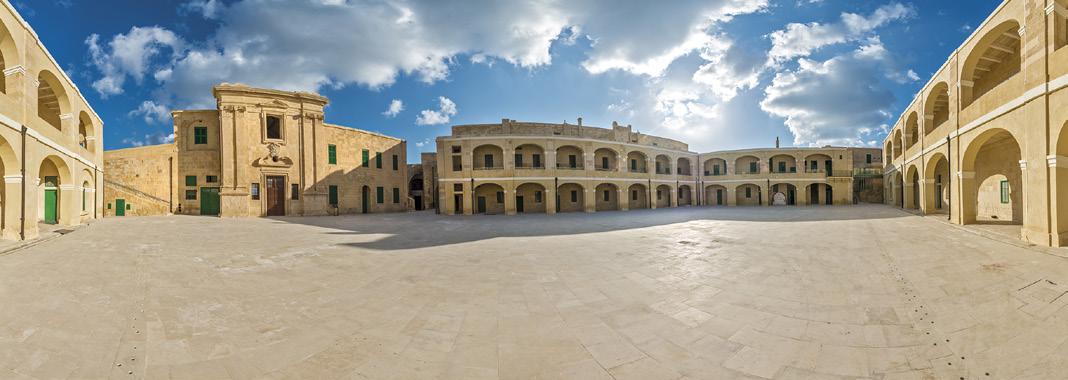
These historic sites will be far from mere backdrops for the exhibitions, their presence and historic significance playing a vital role in the understanding and overall experience the biennale seeks to present.

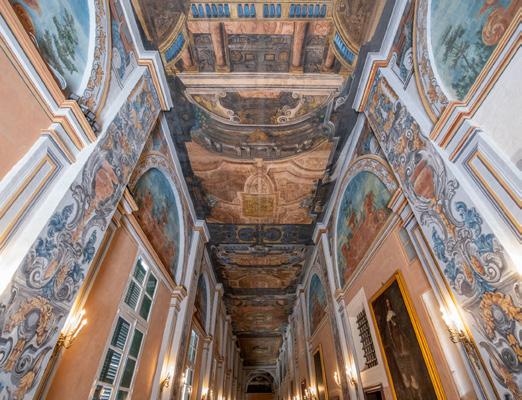
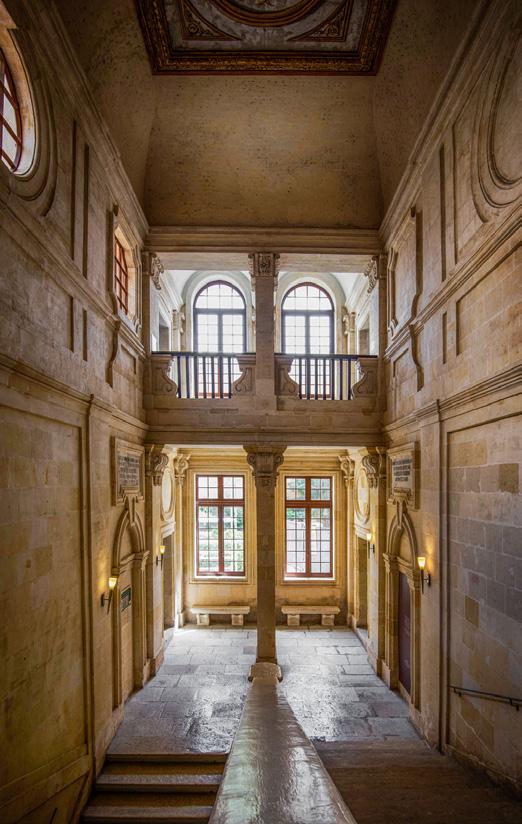
IF YOU’RE LOOKING FOR A KEEP-SAKE, A TOKEN FROM YOUR LAST MALTA HOLIDAY OR WANT TO TREAT SOMEONE LIVING OUTSIDE OUR ISLANDS, WHY NOT TAKE SOME GENUINE MALTESE PRODUCTS BACK HOME WITH YOU?

Simonds Farsons Cisk plc is synonymous with a beerbrewing tradition rooted in quality. At the base of this tradition are long-established skills of selecting nature’s best ingredients, coupled with the expertise of skilled and dedicated brewers that ensure a high standard of quality is maintained at every step in the brewing process. Over the years, this dedication has contributed to creating award-winning brews that so many have grown to appreciate. Cisk Lager, launched in 1929, is a golden-coloured, bottom fermented lager with a distinctive and well-balanced character and an alcohol content of 4.2%. The range also includes Cisk Export – a smooth, well-balanced and exceptional beer with a 5% alcohol content; Cisk Excel – a low-carbohydrate beer; Cisk Chill – flavoured beer available in three flavours; Cisk Pilsner – a premium pilsner with an alcohol content of 5.5%; and Cisk Strong – an outstanding extra-strong premium lager with a 9% alcohol content.
Cisk is available on amazon.co.uk

Kinnie, Malta’s own favourite soft drink, is a unique tasting bitter-sweet beverage, with orange flavouring and aromatic herbs. Kinnie is best enjoyed ‘neat’, with a slice of orange and lots of ice. Highly refreshing, it is also an excellent mixer.
These distinctive characteristics have made Kinnie a Mediterranean classic since 1952, loved by the local population and tourists.
Over the years, in keeping with evolving trends in lifestyles and health awareness, a zero-sugar version, Diet Kinnie, was introduced, as well as Kinnie Zest – also a zero-sugar variant, however with an intense orange flavour.
The Kinnie range is available on amazon.co.uk; kinnie.com


Get your E xplore Flex card from our shops in the Welcomer s’ Hall at the Airpor t and in the Vallet ta Bus Terminus.
You can al so get your E xplore Flex card from any one of our card machines located at the Airpor t, Buġibba Bus Terminus, Pembroke Park & Ride, Sliema Ferries, Ross Bus Stop in St Julian’s, Vallet ta Bus Terminus, and Mġarr Ferr y Terminal and Bus Terminus in Gozo.


TWO HISTORIC CITIES, ONE ANCIENT CRAFT AND ALL THE EXCITEMENT OF NEW BEGINNINGS… AS THESE CUTTING-EDGE LEATHERSMITHS CREATE THEIR LUXURY DESIGNS.
As with everywhere the world over, artisanal is on the up and mass-produced is on the down. With our current focus on the wastefulness of fast fashion and the carbon footprint of everything we purchase and consume, ‘local’ is truly having a moment.
Truth be told, I hope that it’s far longer than just a moment, because this shift is creating an exciting entrepreneurial ecosystem in Malta.
On either side of the Grand Harbour are monumental fortifications in dusty limestone. Though the Three Cities precede Valletta, both are ancient city-fortresses, dating back to the 1500s and earlier. Both witnessed a devastating decline after sustaining heavy bombardment in World War II. With vast swathes in ruins, many residents who had left for the countryside never returned and the abandoned palazzos and houses soon became slums.
Fast-forward to the end of the 20th century and the notion of gentrification began to take hold. After all, Valletta is a UNESCO World Heritage city, built in 1574, and Vittoriosa (Birgu in Maltese) dates back even further with both being jewels in the crown of our architectural history. With the rise of global consumerism in the
1980s, many local manufacturers went out of business and their shuttered stores became a sad testament to a once-bustling past.
In Vittoriosa, one of the Three Cities, a small shop with a high, arched ceiling was one such property. Right in the heart of the city, where the Knights of the Order of St John used to have their vast auberges, headquarters for each of the Langues they hailed from, is Hilda Tabone Street. Originally called the Collachio in the time of the Knights and later Britannia Street when we were a colony of the Crown, it is probably the last place one might imagine finding a Taiwanese leathersmith.
And yet, if you walk past during opening hours, you’re likely to find Ozzy Chien working away in the workshop area, creating everything from belts to bags, wallets and custom orders for his more adventurous clientele.
Birgu Blue was founded a few years ago although it feels as though it’s been a part of the area’s fabric for decades. Perhaps it's because of the organic way in which the old property was renovated, allowing the limestone walls and arches to breathe with contemporary steel shelving and a mezzanine level seemingly
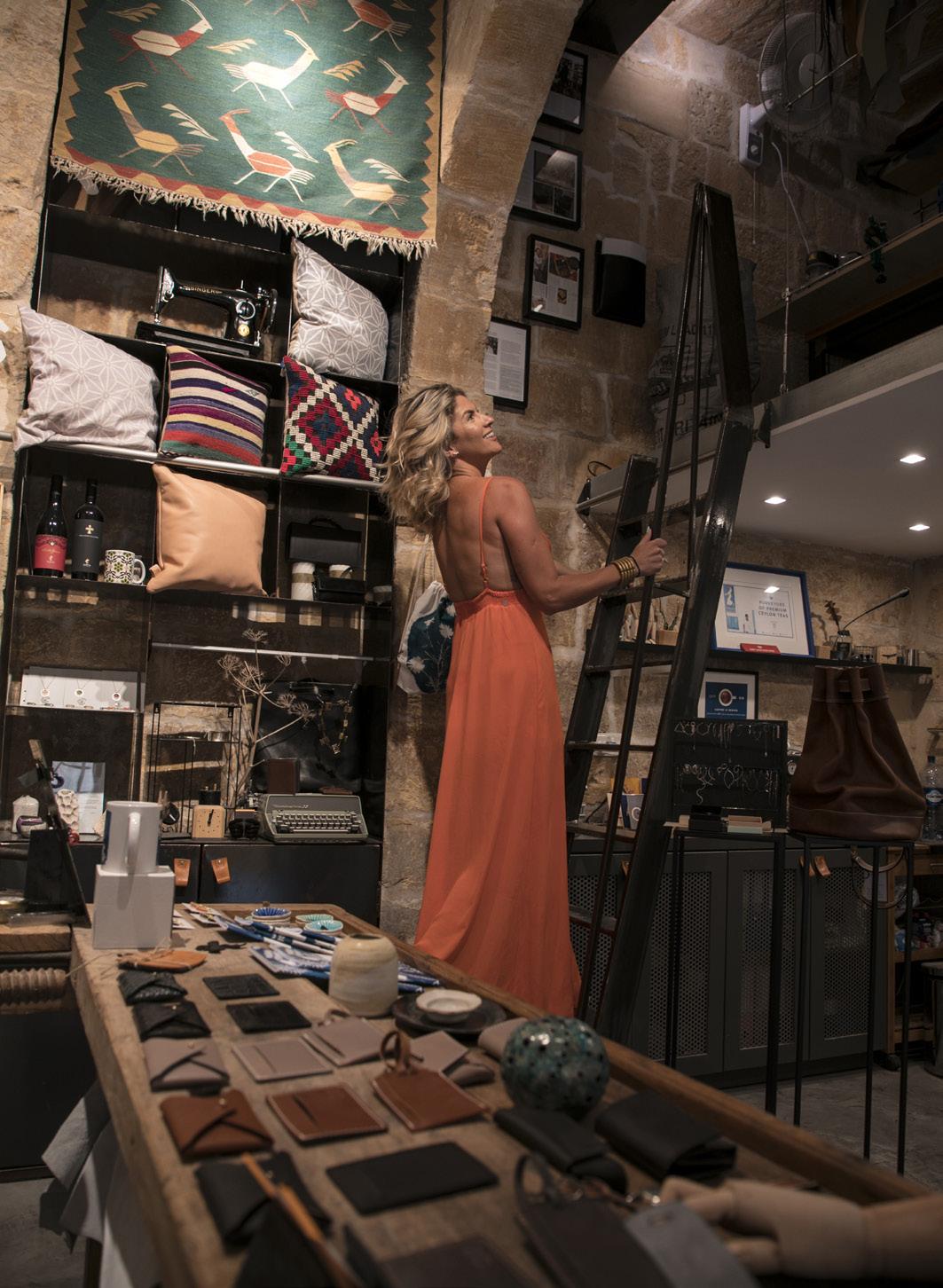

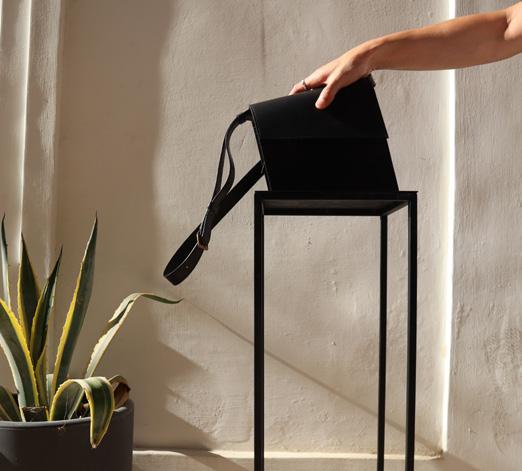

floating above them. It is quite astonishing to look at these walls and see the 15th-century chisel marks, wondering who might have been responsible for that one block.
Ozzy’s journey to Malta came via the home of luxury leathercraft, Italy. After teaching himself the basics back home in Taipei, he moved to Rome to train at the Accademia Costume & Moda. Following that, he was lucky enough to intern with the renowned master leathersmith, Stefano Conticelli. No amount of training can substitute a stint with an expert of this calibre and the level of craftsmanship seen at Birgu Blue bears witness to that.
Besides an annual collection and a constant exploration of different materials and colours, there are also plans on the horizon for working with vegan leather. So, no matter when you visit, there is always something new at Birgu Blue.
Then, a short ferry ride across to Malta’s capital, Valletta, one finds oneself in the newer and improved version of the Three Cities.
The Knights, having barely survived the Great Siege of 1565, knew they had to build bigger and better. Based on a grid form and surrounded by gargantuan sheer walls, this elegant capital is also a mighty fortress.
For t hose arriving by ferry from the far more contemporary Sliema, the fastest way into the centre is through the narrow St Mark Street. For decades, a sad-looking shopfront declared that it was the British Boot & Shoe Factory. Surely there couldn’t have been a more perfect spot for a budding entrepreneur, working with leather, to operate from?
After lots of elbow grease and sleepless nights, Keith Caruana breathed new life into the little shop, now called Captain’s Cut. Keith’s journey couldn’t have been more different from Ozzy’s, yet they are both worki ng with the beautifully supple, vegetable-tanned (more environment-friendly) cow leather, creating stunning pieces for the burgeoning buy-loca l cohort.



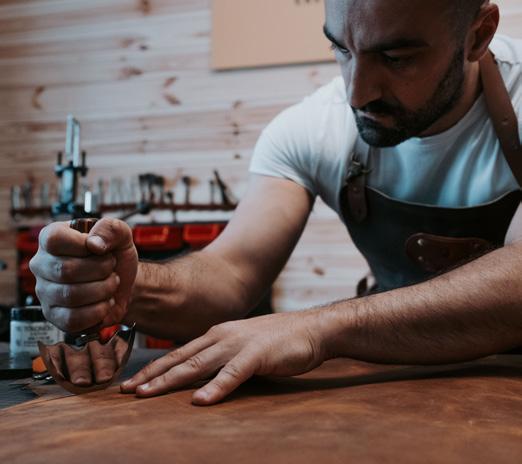

After serving in the army as a Captain, hence the name, Keith was still searching for his artistic, lifetime fulfilment – possibly something that merged his innate creativity with utility and function, while continuing to be of service to the community.
Serendipitously, he had wanted to re-upholster his vintage Land Rover in better leather than what was available locally, so he ordered a roll from Tuscany, only to find it was too thick for the upholstery machines to work with. With an expensive mistake sitting at home and a can-do attitude, Keith set about teaching himself the craft and hasn’t looked back since.
There is no challenge he doesn’t take on, in the simple belief that if he doesn’t know how to make it, a solution is always a few sleepless nights and dozens of cardboard cut-outs away. During last year’s Malta Fashion Week, a collection of over 20 artisans banded together to create a show based around their designs. For a variety of reasons, many pulled out until Captain’s Cut was the only brand left standing. The gauntlet was thrown down and Keith rose to the occasion,
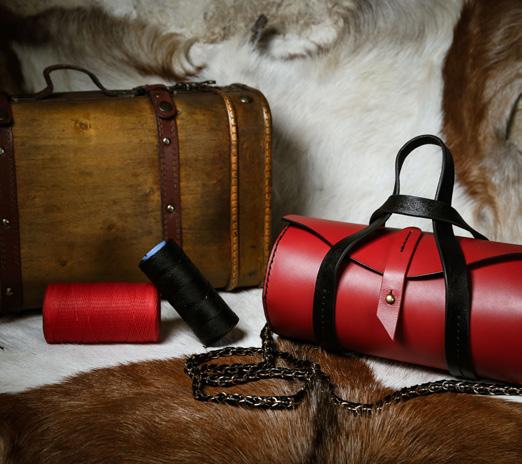

working tirelessly to populate an entire show with his creations. This didn’t go unnoticed and led to one of his most celebrated coll aborations to date with local celebrity stylist Robert Agius. Together they designed an outfit for one of Malta’s most famous singers, Ira Losco, for her act supporting the 2023 EuroPride headliner Christina Aguilera. Robert wanted to create something in the colours of the trans flag and Keith brough this idea to life. These artistic projects go beyond what he offers at his store, where he specialises in custom leather belts and a unique leather gifting experience.
As different as they may be, both leathersmiths embody the exciting spirit that these young start-ups have come to represent. It allows the Maltese to celebrate and support the local market and visitors to leave with a more meaningful souvenir of their stay.
@captainscutleather @birgublue_malta









WIGNACOURT TOWER IS ONE OF THE OLDEST IN EXISTENCE IN MALTA. CENTURIES LATER, DETAILS ABOUT THE COASTAL DEFENCE POST ARE STILL BEING DISCOVERED FROM DOCUMENTS, PAINTINGS AND PHOTOS AS IT CONTINUES TO WELCOME THOUSANDS OF VISITORS A YEAR.
One of the handful of volunteers at Wignacourt Tower, Catherine Pace, still smiles when she thinks about her most memorable visitor to the St Paul’s Bay site. The woman was 91 years old and, as a former archaeologis t herself, she wanted to know everything about its history, even climbing the narrow spiral staircase to see the upper floor.
The staircase is a quaint – if daunting – feature of the tower, appearing on many a social media post. A sign at the bottom warns that backpacks are not allowed, and curator Martin Vella recalls once having to help a young lady back down. It might not be much consolation for today’s visitors, but the spiral staircase is actually a far better solution than the original rope ladder!
A rectangular metal gate halfway up is actually a relic from the days it was used by the parish to teach religious doctrine. It would be swung across the staircase to keep the children upstairs from distracting those downstairs.
Hang on, doctrine lessons? Aren’t we talking about a 17th-century tower? Indeed, we are – and the oldest one in existence in Malta. When the island was given to the Knights of the Order of St John in 1530, it was soon under constant threat from pirates and Ottoman corsairs. In 1610, Grand Master Alof de Wignacourt opened the coastal defence post – built at his own expense. While other towers were constructed much later to have line of sight to each other, at the time, Wignacourt was completely isolated, surrounded only by countryside.
Martin is a walking encyclopaedia about its history, with details – including the fact that by 1913, the tower became the police station – gleaned from his 14 years as a volunteer there, until he took over as curator in 2016.
While Catherine deals cheerfully with two visitors who have walked in, he points to the floor. “You can see where a wall once stood here. This formed the cell that was used by the police,” he explains, adding that in those days they also looked after the postal service.
In 1935, the tower was taken over by the British army to be used as a telegraph centre, using Morse Code to communicate with the operational base at Lascaris in Valletta.
Photos from this time indicate that St Paul’s Bay was still a small village, with the parish register showing probably around a few hundred families living there, many of whom would have been employed in the grand houses of the nobility nearby.
“It hosted a manual telephone exchange at one point, and we still get visitors here who remember it that way,” Martin adds.
The parish took over the tower when the telecommunications hub was moved in 1963, and it was used for classes until the early 1970s. By then, it looked very different: when it was built, a grand staircase led to the first floor, where a drawbridge could be raised and lowered. In fact, you can still see the original door, and – hard as it may be to believe – the original key, which is kept in a framed box! The staircase was removed to help traffic flow around 60 years ago and the entrance is now at g roundfloor level.
Once inside, volunteers like Catherine enthusiastically explain the display boards on the four-metre-thick walls, complete with detailed scale models. They tell the story of the ubiquitous fortifications in Malta, while a video goes into more detail about Wignacourt Tower itself.

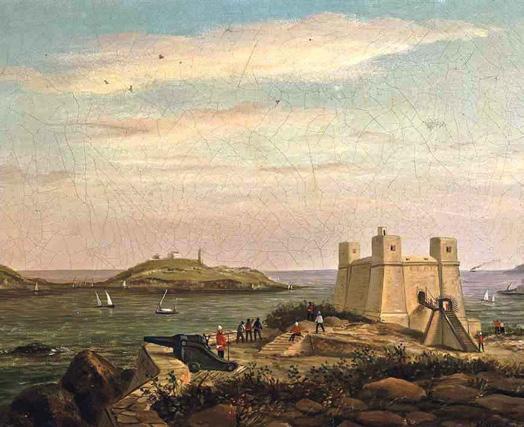
Once up the infamous staircase, the first floor has been laid out to reflect what it must have been like at the time, with its spartan bed, desk and a well (fed to this day by underground water), an old cooking stove with chimney, and even a latrine, which led directly to the sea. Reproductions of weapons like muskets and lances are testimony to the soldiers that would have been assigned there.
A stone staircase takes you up to the roof, with its extraordinary views over St Paul’s Bay – a location chosen with care to defend this bay from intruders. Records show there were three fourpounder cannons in the 18th century, but there is a now one six-pounder, dated clearly as being from 1782. It is in such good condition that it is fired by specialist NGO Show of Arms once a year – albeit without cannon balls and using well under half the amount of gunpowder possible in theory.
Martin points to the ‘balcony’ that juts out over the walls. Contrary to popular belief, the soldiers would not have poured precious water and oil over assailants, but they would have chucked buckets of human and animal waste onto the people 16 metres below.
“Think of it as the first biological weapon,” he chuckles.
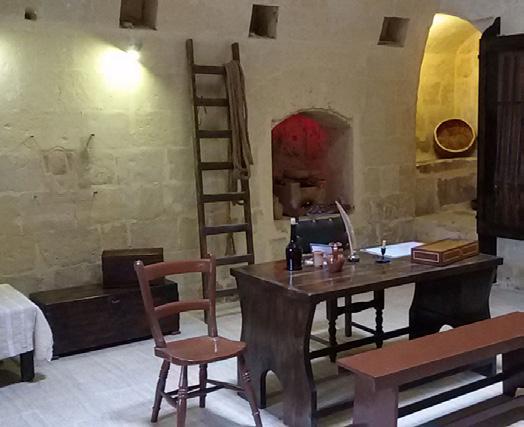
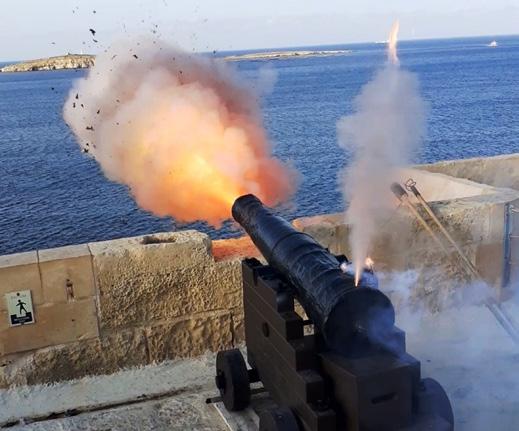
The tower fell into disrepair, and in 1975, the Council of Europe Year for Architectural Heritage, an advert appeared in the Government Gazette asking for interest in its restoration. Din l-Art Ħelwa – the National Trust of Malta at that time had hardly any funds, but the NGO decided to go for it, and poured every cent it had into it. The tower was subsequently granted in guardianship to DLĦ in 2003.
Restored again in 2015, with Malta Tourism Authority and EU funds, it now welcomes thousands of visitors a year, and its surrounding terrace is a favourite for strolling couples and families.
“We are still finding out details from documents, paintings and photos,” Martin continues. “There is still so much to discover about its centuries of history.”
Wignacourt Tower is open daily between 10am to 1pm, Mondays to Fridays, and the first Sunday of each month, pending volunteers’ availability. Visitors are encouraged to contact the Din l-Art Ħelwa offices on 2122 5952, or 2122 0358 when planning their visit.
EVEN WITHOUT THEME PARKS, MALTA IS STILL ONE OF THE MOST CHILD-FRIENDLY HOLIDAY DESTINATIONS IN EUROPE NO MATTER THE WEATHER. LOVE HISTORY AND HAVE KIDS? HERE ARE SOME OF OUR FAVOURITE HISTORICAL SITES THAT WILL EXCITE EVERYONE IN THE FAMILY, BOTH YOUNG AND OLD.
Hurrah! You’re off on a family holiday. The kids are so excited they can barely sit still. Now that you’ve managed to buckle them down with that seatbelt, you can spend the next few hours of this flight thinking of how you’re going to entertain them while in Malta. They may be dreaming of sandcastles, but it’s not exactly beach weather yet. You might be lured by historical palazzos, but would baroque architecture appeal to the kids?
Who said holidays must be a compromise? With 7,000 years of history, real-life fortifications, caves, catacombs and even minimammoth skeletons, there’s something for all ages on this island, which is so small it could very well be described as child-size, not just child-friendly.
I love anything historical, especially ornate churches and romantic palazzos, but this interest is not shared to the same degree by the rest of my family, especially not since I dragged them around all the historical sites in Sicily under a blistering August sun instead of lounging on a beach. They learnt two words in Italian during that holiday, centro storico (historical centre), and for years after they were traumatised by them.
But that experience taught me I had to find an alternative way to market historical attractions on future family holidays. While high art might make my pulse race faster, my children will not lift their eyes off their iPads for any old Caravaggio. Tell them there’s a gruesome beheading in the picture and the artist himself was convicted for murder, then you’ve got their attention.
You wish to visit the rotunda of Mosta? Gloss over the fact that it’s a church and tell your kids you’re visiting the third largest unsupported dome in the world. And if that is not enough to grab their attention, there’s always the story of how, during World War II, a bomb fell through the roof during Mass, rolled down the aisle
and stopped at the foot of the altar without ever exploding. And yes, said bomb is still there for kids of all ages to admire.
Ħaġar Qim and Mnajdra Temples might look like a pile of old stones, but any visitor, no matter their age, is bound to get excited when they learn they are among the oldest free-standing structures in the world, pre-dating the Egyptian pyramids by 1,000 years.
Esplora Interactive Science Centre in Kalkara is most likely already on top of your itinerary, so that’s one morning covered. The Malta National Aquarium is always a hit. But what about the rest of your stay? Heritage Malta has created a range of audio-guides at their sites specifically for children, interactive touch screens with different activities, and children’s areas within some museums where the kids can play, draw, or do crafts related to the site. They also organise special activities that bring history to life, and this month, children can participate in activities related to Good Friday at the Inquisitor’s Palace in Vittoriosa, where they will learn how to make the typical Maltese Lenten biscuits, kware ż imal.
While children are welcomed in all of Heritage Malta’s sites, there are two locations that are off-limits for younger visitors: Ħal Saflieni Hypogeum and Underground Valletta. Heritage Malta senior principal officer for education and outreach Vanessa Ciantar explains “both are dark, underground, sometimes slippery places, which require secure footing”.
Here are some suggestions that have passed the child-friendly test, at least with my two kids:
THE MALTA EXPERIENCE, VALLETTA
If it’s too hot or too rainy, there’s only one solution: go to the cinema. Housed within the 16th-century fortifications of the capital city (to keep the history buffs happy), the award-winning
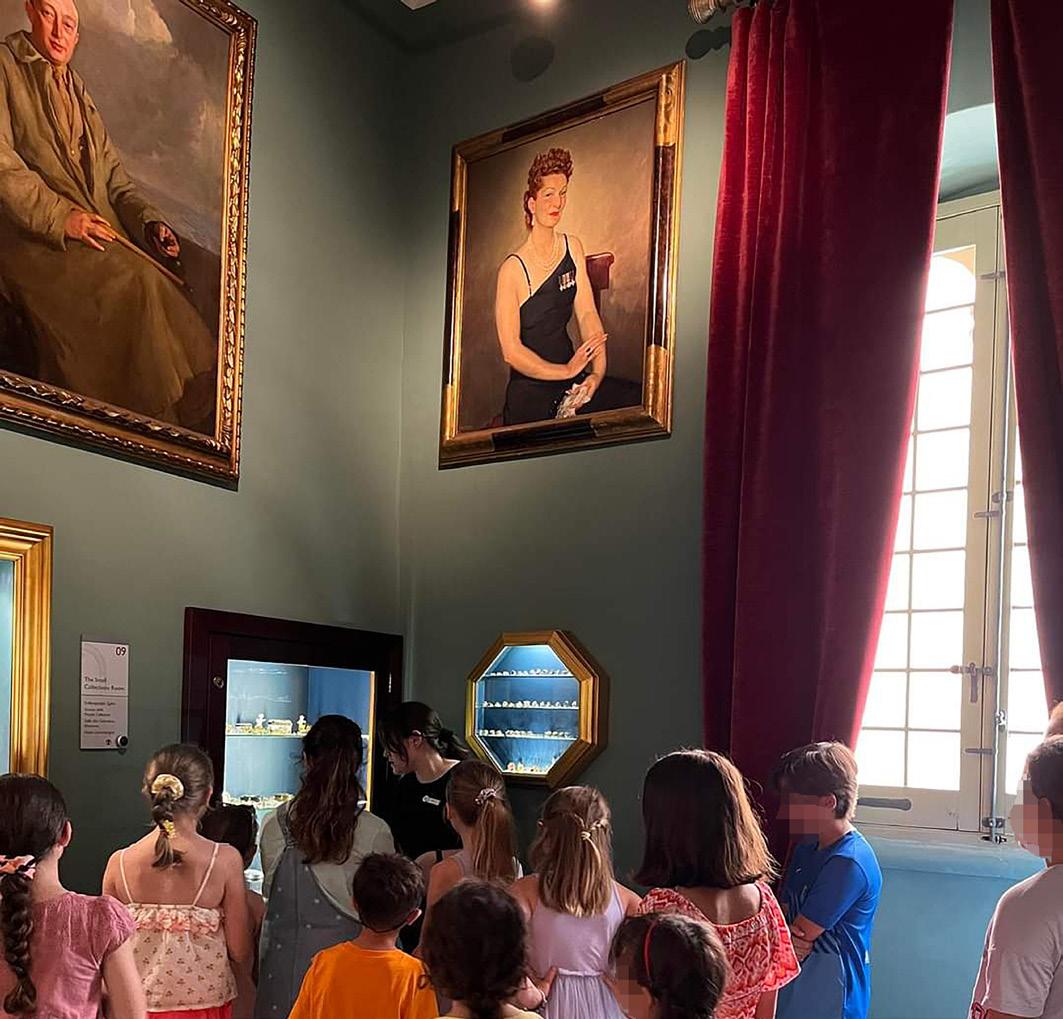
audio-visual show covers 7,000 years of history in 30 minutes, which is just the right length before younger kids get bored and start demanding more popcorn. My children where both under 10 years of age when I took them to watch it, and both enjoyed the dynamic music and vibrant narrative although my daughter pointed out it might be “better for older kids who can understand what is happening and not get frightened by the film”.
Who doesn’t love the Romans? The remains of a rich, aristocratic, Roman townhouse, dating back to the 1st century BC, were accidentally discovered outside the walled city of Mdina in 1881. It features exquisite mosaic floors and the only set of marble statues portraying th e emperor Claudius and his family, normally found in public spaces, to be seen in a private house anywhere in the Roman Empire.
Oh dear, I can see the kids are yawning already. But fear not, the museum is house-sized and can be visited in less than an hour without tiring their little legs. What I found fascinating is that it takes the visitor through the various aspects of a typical rich Roman household, and you learn how a Roman family divided their roles within the house, their fashion, their education, entertainment, food and drink and how they decorated their home. It’s basically like visiting a rich uncle’s house, but from centuries ago. And don’t worry about the priceless objects – they’re all safely behind glass.
After Esplora, this is probably the most popular attraction for younger visitors. Just say the words ‘cave of darkness’, which is what Għar Dalam means, and you’ll have them hooked. Throw in two roomful s of fossils and bones from the Ice Age (the real one, not
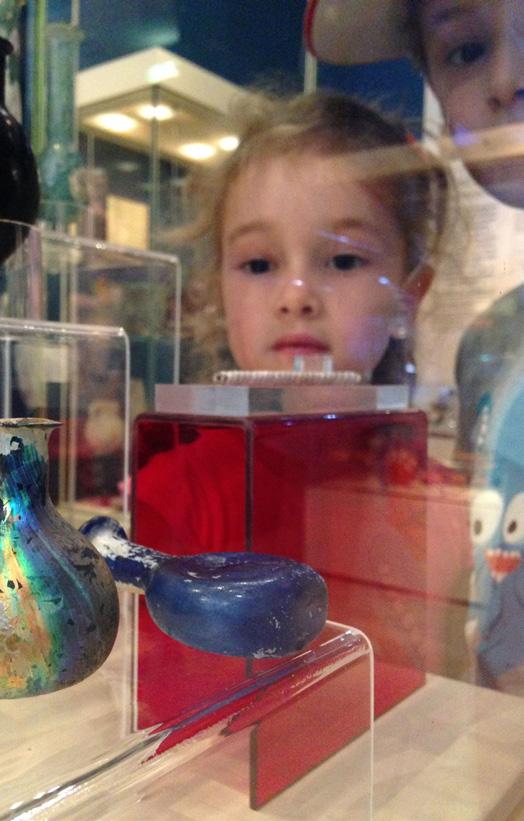
the animation film version), like dwarf elephants and hippopotami, and you’ll never get them out of there. Malta’s oldest prehistoric site is a snapshot of the island’s geological history over five main layers, with the oldest dating back 500,000 years. The top layer holds the earliest evidence of human presence in Malta 7,400 years ago. I can still hear my son cry out: “Cool!”. The cave is 144 metres deep but only the first 50 metres are accessible to the public.
You might not think that World War II holds any interest to youngsters today, but this underground complex remains a fascinating and important testament to the events that changed the face of Europe. Opened in 1940 to accommodate the Combined War Headquarters of all three services underground, Malta’s “best kept wartime secret” housed the Fighter Sector Operations Room used during the Battle for Malta between 1940 and 1943. After the end of the war, it was used by NATO until 1977 to track the movement of Soviet subs in the Mediterranean. Buried deep within the 16th-century fortifications of the capital Valletta, the entrance is reached down several flights of steps and through an atmospheric tunnel. This is pure adventure on a thrilling scale.
Let’s start with the location itself. The star-shaped fort was built
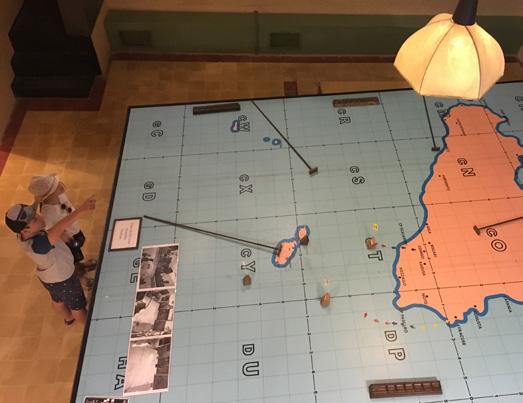
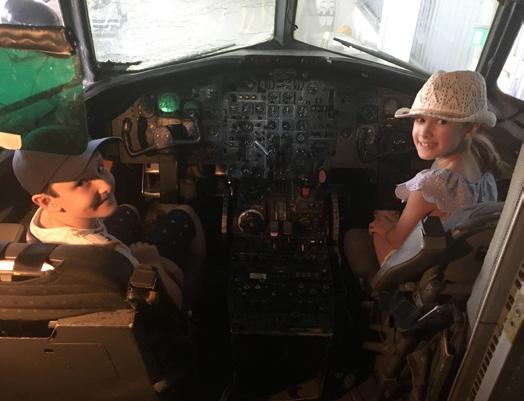
as a “war machine” on the tip of the Sceberras Peninsula, on which Valletta would l ater be constructed, keeping a watchful eye on both Grand and Marsamxett Harbours. In teen language, the views are “fire”! It witnessed the brutal force of the Ottomans during the Great Siege and has guarded the island from incursions ever since. Given its pedigree, it was natural that today it should house the National War Museum. Spread over a number of rooms and buildings throughout the fort, the museum traces the island’s military history over 7,000 years. But, for me, the highlight is the World War II section, which features (spoiler alert) the original aeroplane used in the defence of Malta. Now that should keep the kids happy.
MALTA AVIATION MUSEUM, TA’ QALI
Speaking of historic planes, military or otherwise, how about a whole hangar of them located on the former Royal Air Force airfield in Ta’ Qali. This was a particular favourite with my children although that might have something to do with the fact that their grandfather is a former RAF test pilot, who had flown one of the aircraft on display. This is not just a museum but also a restoration workshop, where you can catch a glimpse of their latest project.
ST PAUL’S CATACOMBS, RABAT
OK, so an underground cemetery is probably not top of your list for a family day out. Bear with me. I shall start with a disclaimer:

Scan here to view this property on our website
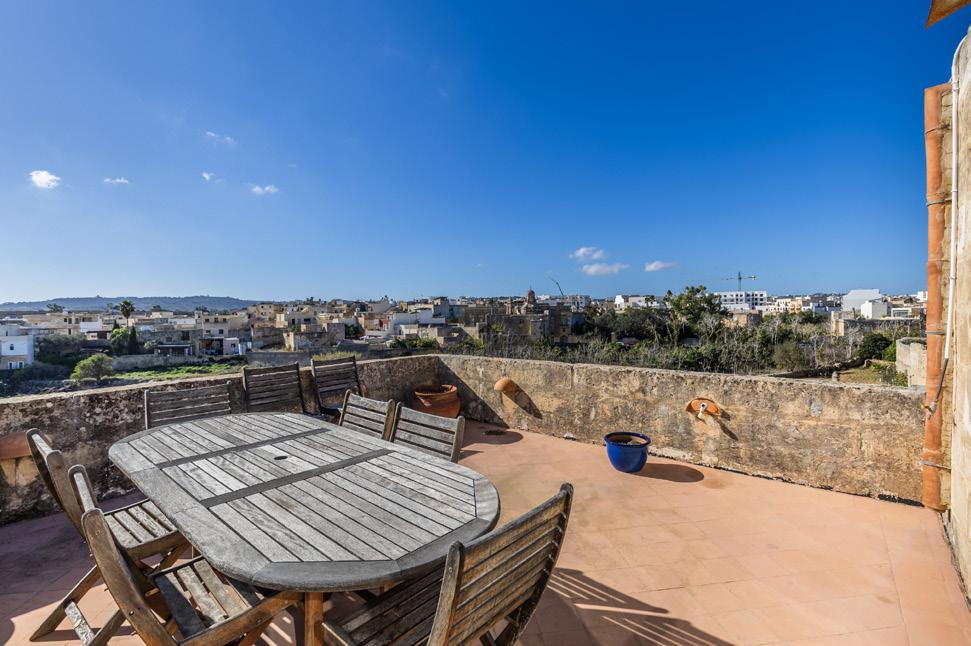
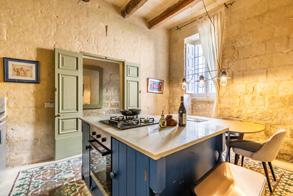

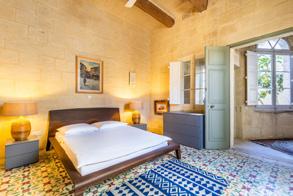
Exclusive - Zebbug | €625,000 | Ref: HC700102
2 bedrooms
2 bathrooms
Internal: 110m2
External: 71m2
This beautifully quaint HOUSE OF CHARACTER with fantastic original features including exposed stonework & wooden beams | Spacious rooms throughout with high ceilings | Fully equipped kitchen/dining space | A separate pantry/boxroom | A living room/study (with a real fireplace) that leads onto a charming courtyard | Cellar | 2 bedrooms | 2 bathrooms (master en-suite) | ‘Garigor’ (spiral staircase) leading up to the roof area | 2 roof terraces - currently one for utilities whilst the other is used for entertaining with a fully-equipped kitchen & separate bathroom | Conveniently located just a short walk to the town centre offering a vast array of amenities.
SOLE AGENTS
View more exclusive listings at perry.com.mt
Call: (+356) 2131 0800 / 0088
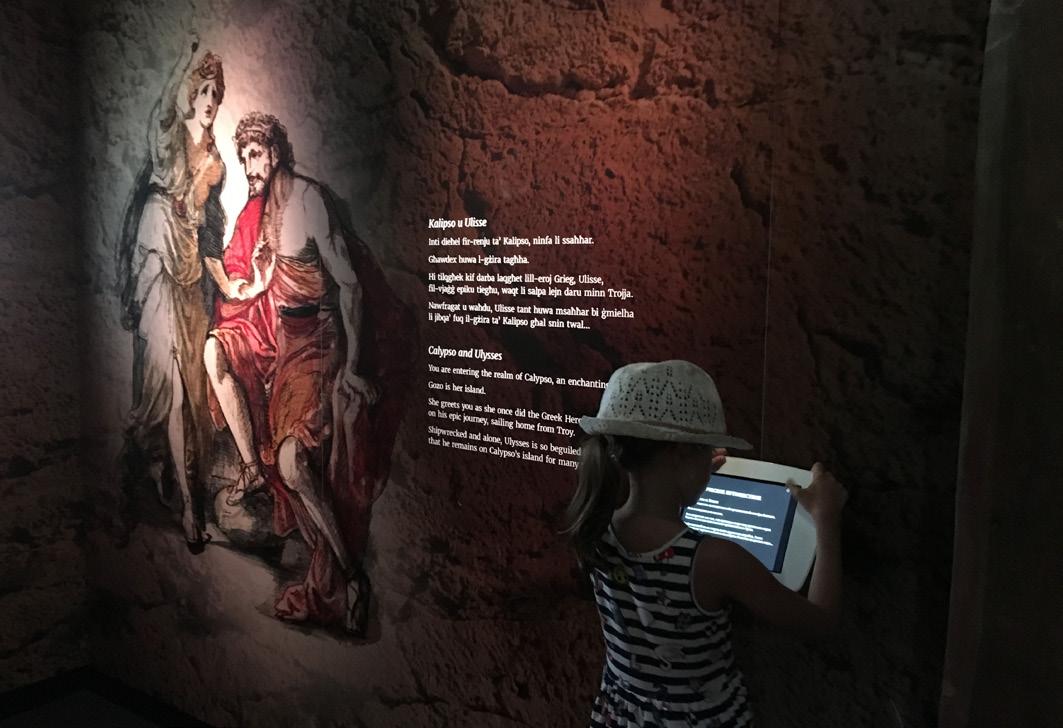
yes, there are skeletons, but only in the visitor centre and in tomb no.8, otherwise the rest of the site is far less ghoulish than you are imagining. St Paul’s Catacombs are at the heart of an extensive complex of over 30 hypogea outside the walls of Malta’s former capital, Mdina, covering an area of 10,000 square metres. They were in use from the 3rd century BC until the 8th century AD, and give a fascinating insight into how people during the Roman and Byzantine eras dealt wi th death. They are an intrinsic aspect of Malta’s past and an altogether alternative way of experiencing history. The 23 catacombs open to the public are accessed via individual entrances scattered around a small, peaceful garden. Some tombs are a rather tight squeeze but, fear not, the number of steps, minimum height and width are displayed outside each entrance, which is helpful. A child-friendly audio-guide will help your kids appreciate the site, and in future, there are plans for an excavation pit to be created for children to dig up their own (replica) skeletons and tombs. One to save for a Halloween visit, perhaps?
PALAZZO FALSON, MDINA
As we all know, bulls should never be allowed to enter china shops. With that logic, children should not be allowed to roam around a palazzo crammed full of priceless artefacts, silverware, glass and myriad trinkets. And in fact, children under the age of six are not allowed inside Palazzo Falson. But anyone who has blown at least six candles on their last birthday cake are more than welcome to partake in the feast of collectibles and curiosities brought together by the artist/soldier/collector/philanthropist Captain Olof Gollcher, who had bought the 13th-century palazzo
in 1927 and lived there until his death in 1962. And not only are children welcome, but they are also given their own little book and encouraged to treasure hunt their way around the fascinating house, exploring it through their own perspective. The palazzo’s EduFun project is specifically designed for children to experience the museum’s rich collection through storytelling, games and animation. Bonus: children aged between six and 12 years old visit the museum for free when accompanied by an adult. Children aged between three and fiv e are invited to attend special workshops inside the palazzo, so check their website for details of the next.
A real-life, fortified, medieval city that looks like it should belong in Hollywood, mysterious ruins, grain silos and an invisible dome: this is history at its most fun! Located on top of a steep hill, overlooking Gozo’s capital Rabat (Victoria), the Citadel dominates the island’s skyline. It is small enough to walk around in an hour although you shouldn’t rush it. It is home to Gozo’s Museum of Archaeology, the Folklore Museum and the Nature Museum. All are perfectly petite and just about the right size for children’s short attention span. There are also a handful of souvenir shops, where I used to buy bookmarks for my children made of bobbin lace. The award-winning audio-visual presentation in the new visitor centre was a particular hit with my children. As it’s entirely car-free, they loved the possibility of running around the maze of narrow alleys, knowing it was impossible to get lost in such a small place, although they did a pretty good job trying.

ST JOHN’S CO-CATHEDRAL HAS BEEN WOWING VISITORS FOR OVER 440 YEARS, AND EVEN ITS NEWLY APPOINTED CURATOR, ADRIANA ALESCIO, CAN’T GET ENOUGH OF THE EXTRAORDINARY BEAUTY OF THE TEMPLE OF THE KNIGHTS.
Nothing prepares you for what lies behind the austere façade of St John’s Co-Cathedral in the capital, Valletta. The jewel in Malta’s crown of architectural treasures and a monument to baroque art, St John’s simply defie s all superlatives. Beautiful, breathtaking, extraordinary, awe-inspiring… I could go on and still not do it any justice.
Adriana Alescio, recently appointed its curator while retaining her other role as head conservator of the cathedral, summed it up in one short word: “Wow!” And she should know.
Originally from the tiny village of Vizzini in Sicily from where she could admire views of Mount Etna, Adriana now calls St John’s Co-cathedral her “second house” as she spends more time there than at home. She first arrived in Malta in 2013 to join a team of restorers working o n a restoration project of three of the nine chapels within the cathedral. What was meant to be an eight-month stint has turned into a 10-year residency for Adriana… and counting.
“I have not finished saying wow,” she confesses, with her eyes sparkling bright as she talks to me about her work at the cathedral. “Of course, I am in love with the building. If I find a couple of minutes to myself and have time to think… I like to spend some time in the oratory up in the balcony.”
Thanks to her work, Adriana has intimate knowledge of every nook and cranny of the cathedral. “That is the privilege of being a conservator and curator,” she says with a smile. “We are allowed to enter and stay in places that are not accessible to others. I can appreciate St John’s from many points of view and from different perspectives – from the roof, from the windows overlooking the central nave, from the organ cage. Every day, we discover something new because of research or work in a particular corner.”
Commissioned by Grand Master Jean de la Cassi è re and completed in 1577, the church was intended as a landmark to be seen from almost anywh ere on the island, rising as it did atop the Sceberras Peninsula on which Valletta was built. Its sombre plain stone mannerist façade, designed by military engineer and architect Girolamo Cassar, reflects the knights’ mood after the Great Siege of 1565, which they won but a t great cost. Initially, the interior was just as simple as its exterior, but the rise of baroque in the 17th century inspired Grand Master Nicolas Cotoner to order the complete redecoration of the interior with spectacularly opulent results.
“I think the Knights did something really extraordinary,” continues Adriana. “They did it for a purpose. Every Grand Master was obliged to gift something to St John’s and each one of them tried
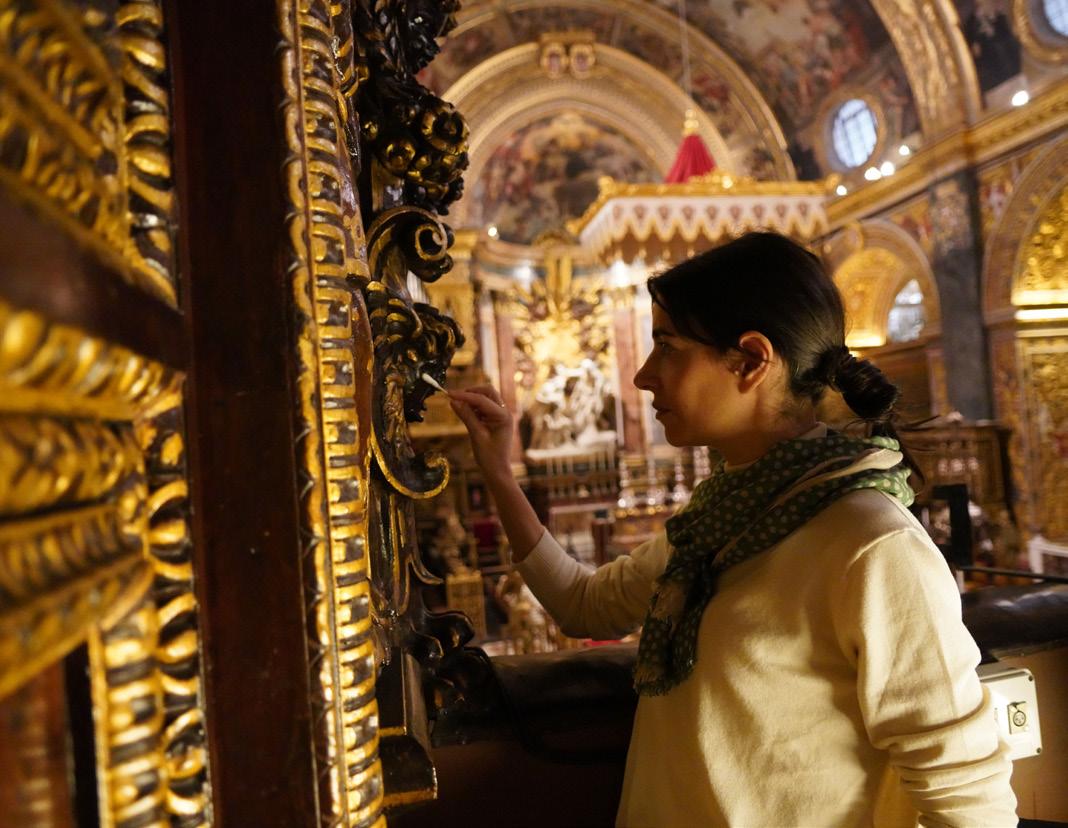
to do his best. In the end, they created something unique. Every chapel (dedicated to each of the Order’s eight langues and one dedicated to Our Lady of Philermos) has some masterpiece and is a microcosm. The amount of works of art is extraordinary. It is beautiful to see the dialogue between every single chapel. They have to answer the big scheme that is baroque, but in every chapel, you find something special, something different.”
The cathedral has becom e synonymous with Caravaggio as it houses two of the artist’s works, but it is much more than that. “This is the house of Mattia Preti,” explains Adriana. “This is the artist’s greatest work of art.” The Calabrian artist, who was anointed Knight of Grace by the Order of St John, painted the barrel-vaulted ceiling and the side altars depicting scenes from the life of St John the Baptist, the patron saint of the Order. He also executed the intricate stone carvings throughout the chu rch.
And as if th e spectacular ceiling and gilded carved walls weren’t enough, the floor itself is also a veritable masterpiece, albeit of a rather macabre nature, as it consists of a marble tapestry of 405 tombstones o f Knights, officers of the Order and other noblemen. “The interior of St John’s is something unique in the world,” says Adriana.
No visit to Valletta is complete without a tour of the cathedral, but its popularity has presented the team of conservators with new challenges of how to balance visitors’ experience while preserving the priceless fabric of the building.
“The first challenge is to preserve the heritage, both tangible and intangible, while welcoming this new wave of cultural tourism. It is not easy to sustain both things. St John’s is an active religious place, hosting the most important religious events, but it is also a museum. We have to respect the value of the place, the liturgical aspect, and preserve and enhance the heritage,” Adriana says.
It is for this reason that the St John's Co-Cathedral Foundation has embarked on the ambitious project of building an extension to the museum adjacent to the church in which to house its extensive collection, including a set of 29 exquisite Flemish tapestries, gifted by Grand Master Ramon Perellos in 1702, a vast amount of silverware and religious vestments.
Not since world-renowned architect Renzo Piano redesigned the entrance to the city and constructed a thoroughly modern House of Parliament has a new building in the heart of the 16th-century capital caused so much chatter among the Maltese, who are justifiably protective of their heritage.

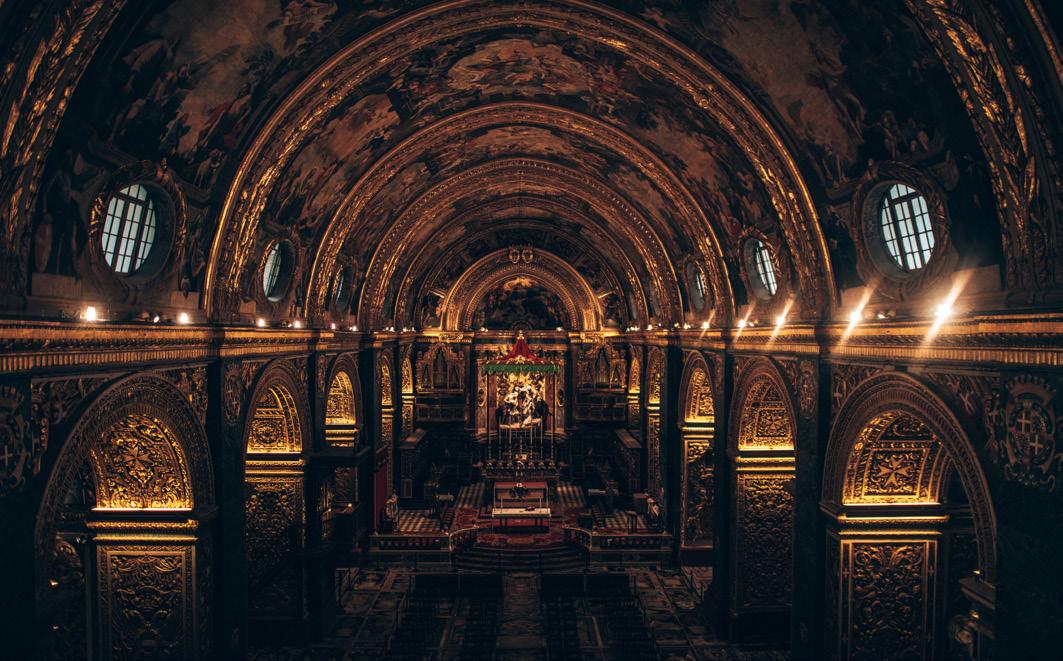
Adriana points out that the museum, which is scheduled to open in 2025, was years in the planning, involving numerous experts, including archaeologists, architects and art historians. It was greenlighted by UNESCO itself because it is listed, together with the entire city of Valletta, as a World Heritage Site.
“Everything is being done for the benefit of the fabric (of the cathedral) in terms of space and aesthetic. The Foundation has never had the opportunity to exhibit the full collection… as the former museum did not have enough space and did not respect good conservation practices. The way we are building the new museum and restoring the old building is in view of giving better space to the objects and respecting best practice of conservation, while offering the best experience possible to the visitor.
“We are doing some structural works that may be deemed strange, or can be invasive, but they can give us the opportunity to exhibit the artefacts in the best way. The museum will be a second house for the Maltese people and for visitors who are in love with art and history,” Adriana enthuses.
It will also include a Caravaggio Wing, which will exhibit the painting, St Jerome Writing, and expand visitors’ awareness of the artist.
“Once you use a place, the deterioration increases. You should fly over the floor to avoid deterioration, but that is impossible,” Adriana continues. “We have managed to take some action by installing protective carpeting and changing the flow of visitors. But the new museum will help create a better balance. The scope is to control the flow of visitors and avoid the massive presence of many people in the same place at the same time.”
While it is a monument to the past, the Foundation is looking ahead at perpetuating its artistic and cultural heritage for generations to come. “I always say that the mission of a restorer is to transmit the beauty in the sense of beauty as balance, harmony, knowledge, wisdom, and when we recognise all these values, the best thing we can do is to pass this on to future generations. This is the highest gesture of altruism. This is the missio n of conservators,” Adriana maintains.
“The mission of the Foundation is to make St John’s an institution and its museum a centre of research, study, conservation and socialisation, because the important thing is to share the knowledge. We hope to create this kind of hub, where people can refer to St John’s as a place of knowledge sharing.”
Wh ether you visit for religious reasons, or purely for the sake of the art, St John’s Co-Cathedral is an experience in its own right. “You can immerse yourself in a beautiful baroque experience; you can take a trip through the mentality of the Order of the Knights of St John. So you can gain, in one go, all the information related to baroque art, plus the meaning of the faith for the Order,” Adriana explains.
And for the team of conservators, restorers and the small army of maintenance and operations workers, who keep the building going every day, the cathedral they know so well is still revealing itself after 447 years. “I think there are still secrets,” concedes Adriana. “The quantity of artefacts is extraordinary. We are always doing research and, sometimes, a project ends up revealing some new detail, a payment slip, or a com mission for some work of art.” The story of the temple of the Knights is still being written today.
With its rich history dating back to the 12th century in northern France, tennis has evolved into a global phenomenon. From Henry VIII of England to Louis X of France, the game’s roots run deep in European history. The modern form of the game, known as lawn tennis, originated in Birmingham, England, in the late 19th century, and tennis is today an Olympic sport, played at all levels of society and by all ages.
The Grand Slam tournaments, the Australian Open, French Open, Wimbledon and the US Open stand out as major events, drawing millions of spectators worldwide.
And tiny Malta, with its perfect mild weather almost year-round, provides an ideal setting for this outdoor play. The numerous tennis clubs across the islands cater to diverse preferences, offering not only the sport, but also a social experience with adjoining bars and restaurants. In fact, tennis is more than just a sport; it’s a vibrant part of lifestyl e. And whether you’re a seasoned player, or a casual enthusiast, the islands offer the right tennis experience.
The Marsa Sports Club, the oldest and largest on the island, features 19 courts, including clay and hard surfaces. Tennisline in Pembroke, run by an international team of pro-coaches, recently opened two brand-new hard courts, perfect for serious amateurs. Close by at the Radisson Blu St Julian’s is Gilly’s Tennis School, while the Swieqi Tennis Club, known for its community vibe, and Żebbuġ Tennis Club, supporting the Maltese national tennis team, are among other options. For those seeking a tennis retreat on the sister island of Gozo, the Kempinski Hotel San Lawrenz provides two hardsurface courts, open to non-hotel guests.
In the heart of this tennis haven is Francesca Curmi, Malta’s prized athlete. At only 21 years of age, this professional tennis player boasts a WTA ranking of 300 (year end 2023). From starting her journey on the Maltese courts at the age of seven, to training in
Serbia at age 12, and subsequently in Barcelona for the past five years, Francesca’s achievements include being the first Maltese in a Junior Grand Slam main draw and winning I TF Pro 15K and 25K titles.
Her determination has put Malta on the international tennis map, earning her admiration and respect on the circuit. Needless to say, the Maltese are proud of this young player and also look forward to supporting her growth on the international circuit.
With an impressive record, including being Malta champion for 18 years, Matthew Asciak of the Asciak Tennis Academy is a dominant force in Maltese tennis. The son of former champions Gordon and Helen Asciak, his journey includes ranking no. 4 in Europe U14, numerous Davis Cup victories, and gold and bronze medals at the Games of the Small States of Europe 2023.
Th e Asciak Tennis Academy, which he established 12 years ago, stands as a distinguished tennis institution in Malta. Committed to excellence, the academy, located within the Marsa Sports Club, boasts state-of-the-art facilities and a team of experienced professionals. They focus on n urturing young talent and empowering individuals to reach their full potential in the sport.
The tennis community in Malta is thriving, with friendly and competitive tournaments regularly organised. The Malta Tennis Federation ensures standards and compliance with ITF regulations, fostering a supportive environment for the game.
Whether you’re looking to elevate your game, or just enjoy a casual match, chasing a love for tennis, or seeking some friendly fun under the Maltese sun, the local tennis scene caters to all skill levels. And the tennis community welcomes you to join in the excitement, so just pick up a racket, make new friends and let the smashing begin!



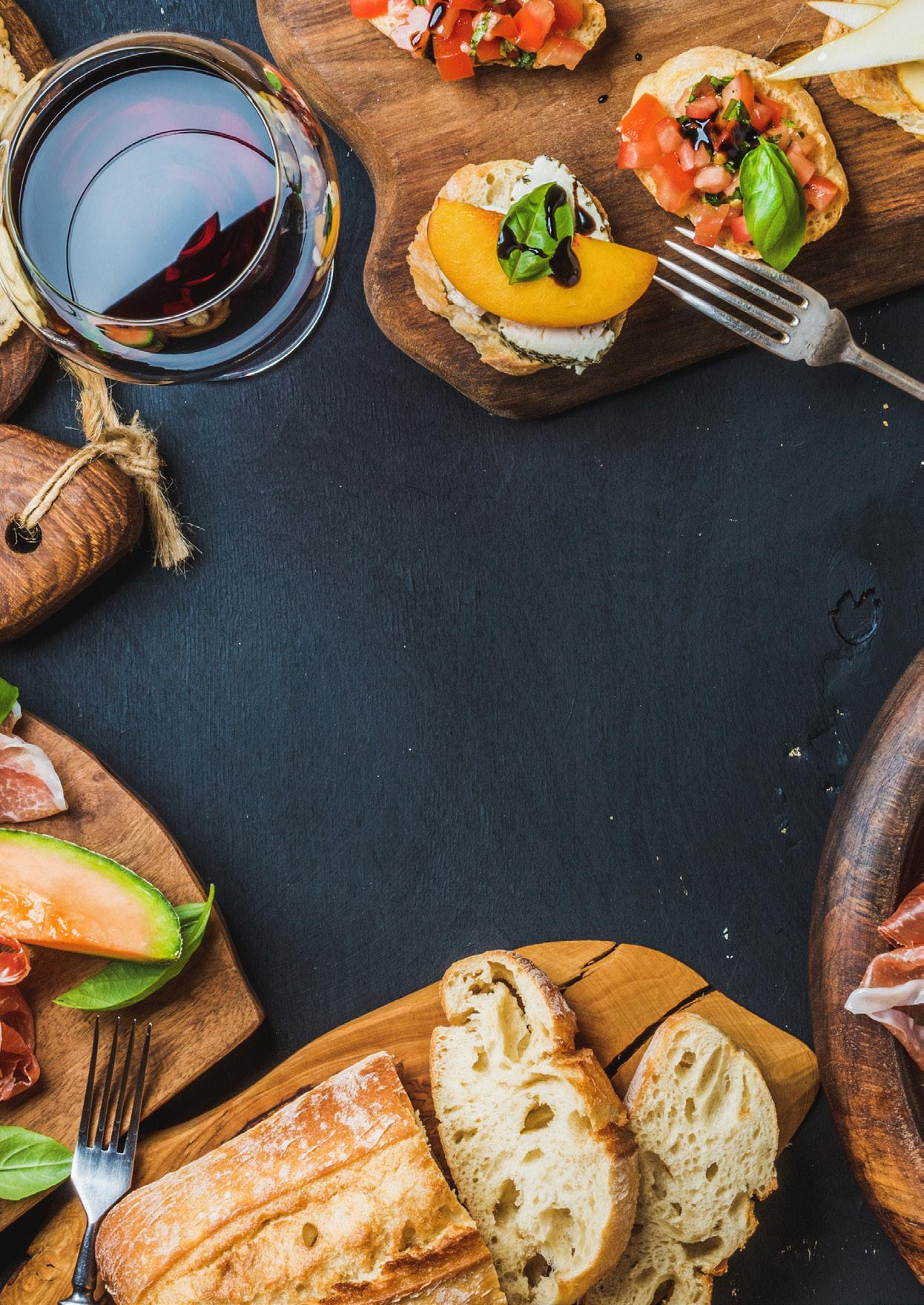

Does a visit to Malta even count if you don’t taste pastizzi ? With an eclectic cuisine that reflects the island’s chequered history, mixing flavours and ingredients from all over the Mediterranean and beyond, Malta has somehow managed to produce a uniquely local snack in the form of the small diamond-shaped, flaky, greasy pies we call pastizzi
Despite being as ubiquitous and selling as fast as the proverbial hot cakes, the origin of pastizzi is as flaky as their famously crispy dough. In short, we don’t know when and where they originated from. For many Maltese, pastizzi have simply just always been part of the country’s gastronomic offering, which is a rather grand phrase to describe something that costs no more than 60 cents.
But the little we do know about the history of pastizzi is that the earliest mentions of them in the 16th century indicate they were initially a rich person’s food, stuffed with either the ever-present ricotta cheese, ġbejniet (goat’s cheeselets), or rabbit meat, and they were only an occasional treat on special festive days.
One thing for certain is that they are not fast food as the dough needs to rest for several hours while the filling must cook long and slow. Pastizzi are still made by hand today and a professional pastizzar can open, shape and fill one pie in eight seconds flat. And that’s super-fast, believe me!
The pastizzi we know today are quite different and much smaller than the original pies. The first recorded reference to a kind of pastizz dates back to 1595 when a well-known local artist, Gio Matteo Stagno, ate “pasticci di carne ” stuffed with meat. The pastizzi that have survived to this day bear a close resemblance to the famous Neapolitan sfogliatella sweet pastries, with their deliciously crispy mille-feuille dough. Pastizzi, of course, are somewhat bigger and generally savoury, although new flavours are now being introduced, even with Nutella, much to the consternation of the purists. They insist they can only have two types of fillings: ricotta cheese, or curried peas, which replaced rabbit during the British rule in the 19th century.
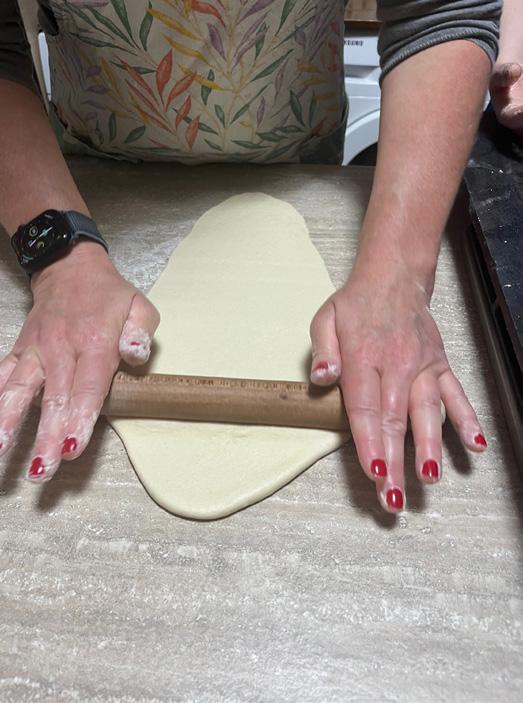
Until the first half of the 20th century, there were no ovens in private homes so any roast meats, or a tray of pastizzi, which were always prepared at home, would have to be taken to the local bakery to be cooked, and then only on special occasions such as Christmas, carnival, or the local parish feast. But by the 1950s, production started on a more ‘industrial’ scale and a trip to the capital Valletta would inevitably include a stop at Dimitri’s for his famous pastizzi “at a time when they were large and stuffed with ricotta and had two crunchy ends”.
However, as their popularity grew, and production moved out of private kitchens and into professional bakeries, they shrank to the current hand-size pie. No more restricted to feast days, pastizzi became an any-time-of-day snack, popular at breakfast, washed down with milky tea served in a glass, never a teacup, and particularly welcome at 4am after a good night out. No party was complete without mini pastizzi
While the diamond-shaped flaky pastizzi are the more traditional variety, there are also round puff pastry alternatives, known as tax-xema (of the candle or wax like).
So ingraine d are pastizzi in Malta’s heritage that emigrants have taken th e recipe with them to their adopted countries, and they are now made and sold among the Maltese diaspora in Australia, Canada, the US and the UK. They have even earned a place in the Maltese idiom as a pastizz also refers to someone who is an i diot or naive or, rather naughtily, used as a euphemism for female genitalia.

Having eaten far too many pastizzi in my lifetime for my own good, I never actually tried making my own. It was just too convenient to pop into a local pastizzeria to buy them, piping hot straight from the oven, that irresistible smell wafting down the street. So, I decided to learn more about these iconic pies, and who better to ask than pastizzi queen Michela Cefai, who has been teaching the “messy” art of making them for a number of years.
We meet in her kitchen where flour, water, salt and an alarmingly large mound of margarine are laid out on the countertop. We start by measuring out the plain flour, seasoned with a teaspoonful of salt, onto the kitchen counter and form a well in it.
“Make sure the walls of your flour mound around that hole are strong enough,” Michela instructs me as I play around like a child building a sandcastle. I soon understand why as she pours a cup of tepid water straight into that flour hole and we gently begin the process of forming the dough, using only enough flour as required. In fact, only about two-thirds of the flour is needed to form the soft dough and the rest gets scraped off and thrown away. After kneading it to the right soft and springy consistency, we smear a small amount of margarine, never butter, on the dough and start rolling it out.
So far, so straightforward… Can I use a mixer to skip this messy part? No, it seems nothing beats working the dough by hand to achieve the correct texture, and I soon understand why. Michela is not happy with my warm hands as the dough must remain cold, so the margarine doesn’t get too soft. She tells me how most bakeries that used to produce pastizzi in the past were always underground,

where humidity and temperature were more constant. In fact, she doesn’t make pastizzi in the summer as it is simply too hot for a good dough not to mention to turn on an oven.
As I roll out the pastry, Michela helps me by lifting one end gently and stretching it before I continue rolling until it grows into a 50cm rectangular strip and is almost transparent enough to see the countertop through it. And now for the rest of that mound of margarine. We take generous blobs and smear it all over the rolled-out pastry. Using her hands, Michela then shows me how to start rolling the pastry from the narrowest end, moving on to her own piece of pastry to roll that on top of mine until we have one large ‘margariney’ sausage roll of dough.
Yes, we have successfully made pastizzi dough. But it now needs to rest in the fridge for around eight hours and I finally understand why pastizzi are not fast food. Michela also reveals that the curried peas filling we will be using later had been cooking since 8am that morning. “It shouldn’t really be street food as it’s definitely not fast food; it can’t be,” Michela points out. “If the dough doesn’t rest, the magic doesn’t happen; it will not puff up and flake.”
While we wait for “the magic” to happen, she explains how pastizzi were never a poor man’s food as the lower classes subsisted on a meagre diet of vegetables, sometimes eaten even raw, soup, perhaps a small fish, coarse bread and goat’s cheese and certainly nothing as elaborate as a pie. While the price of pastizzi has gone up over the years, they still remain cheap and affordable, which leaves Michela “very torn”. She likes that they are so cheap, but at the same time,
feels we don’t appreciate the hard work that goes into this art.
A graduate in tourism, travel and culture, Michela recounted the story of a pastizero who started making pastizzi in Vittoriosa, but when his wife died suddenly in mysterious circumstances in 1580, the Church decided it must have been this food that killed her and so banned them. Later, in the early years of the 17th century, the Dominican Friars in Vittoriosa added pastizzi to their menu as an occasional treat.
So, is she team ricotta or team piżelli (pea)? “I’m definitely a oneof-each girl. And I’m not one to shy away from new flavours. It’s the pastry that really gets me.” And she’s not the only one.
Once the dough has rested enough, Michela works quickly with just the tips of her cool fingers to shape and fill the pastizzi, closing the ricotta ones down the middle, as per tradition, and the curried peas ones down the side. The metal tray goes into a hot oven and Michela explains that it is that contrast between the cold pastry laminated with margarine and the hot oven that will produce the “magic” flakiness.
Never have 15 minutes seemed longer and I cannot tell you if Michela revealed any other nuggets of interesting history about pastizzi in the meantime because the aroma was far too distracting. As she pulled out the tray of golden crispy wonders, I had little polite patience left before doing the very Maltese thing of sinking my teeth into a burning hot pastizz , and with tears streaming down my face, declared it the best snack ever.

200g flour
1/2 cup of water
Half tsp salt (2g)
100g margarine (or lard)
METHOD
Mix together the flour and salt. Create a well in the flour and pour the water in the middle. Slowly mix in the flour by hand, kneading until the formation of a soft dough that is no longer sticky. You may not need to use all the flour. Form the dough into a ball and smear it with some margarine. Let it rest for 20 minutes to one hour, depending on how cold or humid it is. Roll out the dough into a very thin, long, cone shape. Smear the rest of the margarine all over the dough with your hands. The more margarine you use, the crispier the pastry will be. Starting from the narrowest end, use your hands to roll the dough into a snake-like shape. Cover with clingfilm and let the dough rest again in the fridge for up to eight hours or 30 minutes in the freezer if you want to speed up the process. The dough will keep in the fridge for two days. Using a sharp knife, cut pieces of the dough, about two fingers wide. Dip your thumb into some oil, place the piece of dough between your thumb and forefinger on your other hand, and using the oily thumb, open up the dough until it is a disc shape. Work quickly to avoid the dough getting too warm. Fill the disc, seal and place on a metal tray (no need for greasing).
Bake for 15 mins or until golden at 250ºC in a fan-assisted oven.
1 can of peas (420g)
5 white onions
2 tbsp curry powder
2 minced garlic cloves
Salt and pepper to taste
200g ricotta
25g grated hard cheese (or ġbejna, local goat’s cheese)
Salt and pepper to taste
A pinch of grated nutmeg
METHOD
For the ricotta cheese filling, mix all ingredients together and set aside in the fridge until ready to use. For the peas filling, heat up some oil in a frying pan; then add the curry powder to bring out the flavours. Sauté the onions and garlic until they become translucent, then add the peas. Canned peas work better than frozen peas as they are already softer. Allow to cook on a low heat until dry, stirring occasionally. Blend into a paste-like consistency. It is important that both fillings have a ‘dry’ consistency.
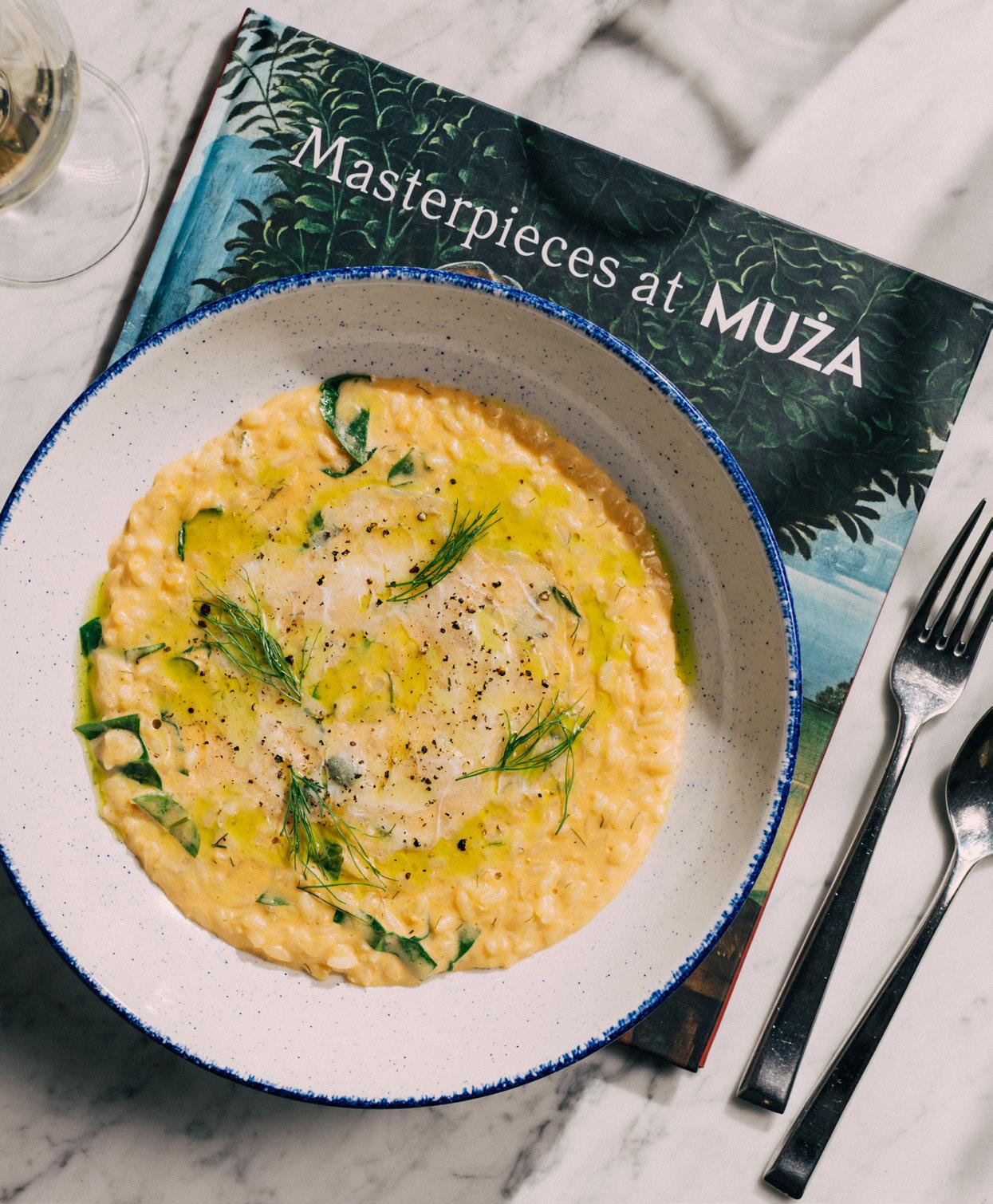

The ġbejna is a traditional cheeselet, crafted from either sheep's or goat's milk, employing rennet to coagulate the curds. These delightful ġbejniet come in various forms: fresh, sundried, salt-cured, or peppered. In Malta, the ġbejna plays a versatile role, utilised for filling ravioli and the classic baked pastry delight, pastizzi
This month, MUŻ A Restaurant head chef Rebecca Sant skilfully embraces tradition, infusing innovation by incorporating the ġbejna into a delicious pumpkin risotto, showcasing a harmonious blend of flavours and culinary heritage.
200g carnaroli rice
1 finely chopped onion
4 cloves of minced garlic
500g pumpkin
A knob of butter
1 tbsp honey
100ml white wine
500ml vegetable stock
50g cream cheese
100g local salt-cured ġbejna
Fresh thyme
Gozo sea salt
Note: Ensure all ingredients are prepared and measured before starting the cooking process for a smoother and more efficient experience.
For the pumpkin purée:
Preheat the oven to 200ºC. Cut the pumpkin into cubes and arrange them on a parchment paper-lined tray.
Drizzle honey over the pumpkin and season with cracked pepper, thyme and Gozitan sea salt. Roast in the oven for approximately 20 minutes or until the pumpkin is lightly golden. Once done, blend the roasted pumpkin with 100g of vegetable stock and a knob of butter until smooth.
For the risotto:
In a large pan over medium heat, heat two tablespoons of olive oil. Add chopped onion, garlic, thyme and carnaroli rice, stirring until the rice turns golden brown.
Pour in the white wine and half of the remaining stock, continuously stirring as the rice absorbs the liquid. Gradually add the remaining stock, allowing the rice to cook and combine. Incorporate the prepared pumpkin purée into the risotto, stirring over low heat. Introduce cream cheese for a luscious creamy texture. Season to taste.
Plate the risotto and garnish with shavings of local goat cheese, cracked pepper and your preferred herbs. Enjoy your meal!

Established in 1964, Ta’ Marija is one of the island’s most historically rich restaurants. Head to their Folklore Dinner shows held every Friday, as well as other evenings, for a touch of Maltese liveliness. Transport can also be arranged. Their gastro menu is bursting with creativity with what is locally traditional, while adding their own signature flavours of sumptuousness. From smallsized appetizers and platters, ideal for those of you looking to experience a variety of flavours, to traditional home-made ravioli, Ta' Marija brings you your favourite Maltese dishes in a way you never imagined. Mains include traditional and signature Maltese dishes ranging from a popular rabbit selection to fish and shellfish in season, local meats and the famous ‘Whisper’ chargrilled steaks, as well as any specials offered on the day. Be sure to leave room for their mouth-watering home-made desserts.
+356 2143 4444
www.tamarija.com
info@tamarija.com

Merchants Street, Valletta
If you're looking for an extraordinary dining experience in the capital city, book a table at MUŻA Restaurant. This establishment boasts numerous positive reviews, and it's easy to see why. Situated in the picturesque courtyard of an old auberge, MUŻA provides a cosy, laidback ambiance, perfect for a romantic dinner or a night out with friends. The menu is bursting with fresh, local ingredients, and the knowledgeable staff can help you select the perfect wine to complement your meal. Plan your visit to MUŻA and treat your palate to an unforgettable culinary journey.
+356 7979 0900
www.muzarestaurant.com.mt catering@muza.org.mt
MUŻA Restaurant muzarestaurant

Misraħ il-Parroċċa, Rabat
The Grotto Tavern restaurant offers a unique and unforgettable dining experience in the heart of Rabat. Nestled in a local indigenous cave, the ambience is enchanting and romantic. Chef Mark Gauci expertly crafts a tasting menu that showcases his passion for local ingredients and traditional Maltese flavours. Patrons rave about the exceptional service, mesmerising setting, and delectable dishes. From fresh seafood to succulent meats, each course leaves diners eagerly anticipating the next. A visit to the Grotto Tavern is a must for those seeking fine dining with a twist.
+356 7945 3258
www.grottotavern.net
info@grottotavern.net
Grotto Tavern
thegrottotavern

Triq San Pawl, Rabat
Bottegin Palazzo Xara is the perfect place to eat out in Malta. A band club and social spot, it offers an authentic local dining experience. The beautiful and inviting courtyard, coupled with outstanding cuisine, ensures a memorable dining experience. Customers on TripAdvisor and Google have raved about the restaurant's cosy atmosphere and excellence in both food and service, describing it as “one of the best places to eat in Malta”. Don't miss out on the opportunity to sample some of the finest Maltese cuisine, and book your reservation at Bottegin Palazzo Xara today.
+356 7945 4538
www.bottegin.com.mt
info@bottegin.com.mt
Bottegin Palazzo Xara botteginpalazzoxara

The Brewhouse, Mdina Road, Birkirkara
The Cisk Tap is the home of Malta’s best loved brew. Located on top of The Brewhouse and set against spectacular panoramic views of Malta, The Cisk Tap is both a modern rooftop venue and a timeless tribute to the Cisk brand legacy. Offering a superb and unforgettable experience, The Cisk Tap is the perfect place to unwind and relax over an impressive selection of drinks, delightful bites and, of course, the finest and freshest brews.
+356 2779 6713
www.thebrewhousemalta.com/life
thecisktap
thecisktap

St George's Road, St Julian's
Hugo's Lounge, an esteemed restaurant specialising in Asian Fusion Cuisine, has moved to Hugo's Boutique Hotel, and has upgraded its menu to offer an even more memorable dining experience. The new Hugo's Lounge boasts an elegant and modern interior design, and offers a wider range of Asian-inspired dishes as well as cocktails. Overall, Hugo's Lounge is a mustvisit destination for foodies seeking an exceptional Asian dining experience, promising an unforgettable culinary journey that is sure to leave a lasting impression.
+356 2742 1217 hugoslounge hugosloungemalta



Beach Garden Hotel, St George's Bay, St Julian's
The art of crafting authentic gelato Vero Gelato is where the art of crafting authentic gelato artigianale reaches new heights. Nestled in a local laboratory, the finest and freshest ingredients available are meticulously blended, resulting in top-quality gelato that showcases genuine flavours and irresistibly smooth, creamy textures. Experience the essence of premium, authentic Italian gelato on the picturesque island of Malta today, exclusively at Vero Gelato's locations in Valletta, St George’s Bay and Spinola.
+356 2010 5590
info@beachgardenmalta.com
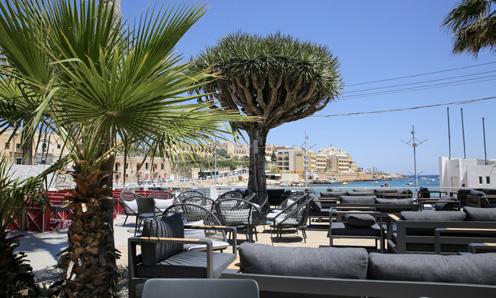
St George’s Bay, St Julian’s
Looking for a place to enjoy shisha in Malta with stunning sea views? Look no further than Luxor Club, located opposite St George’s Bay in Paceville. This cosy lounge has everything you need for a perfect evening out, including tasty food and cocktails, and a great selection of music to set the mood. Whether you’re looking to relax with friends or celebrate a special occasion, Luxor Club is the perfect place.
+356 2010 5590
luxorclubmalta
luxorclubmalta
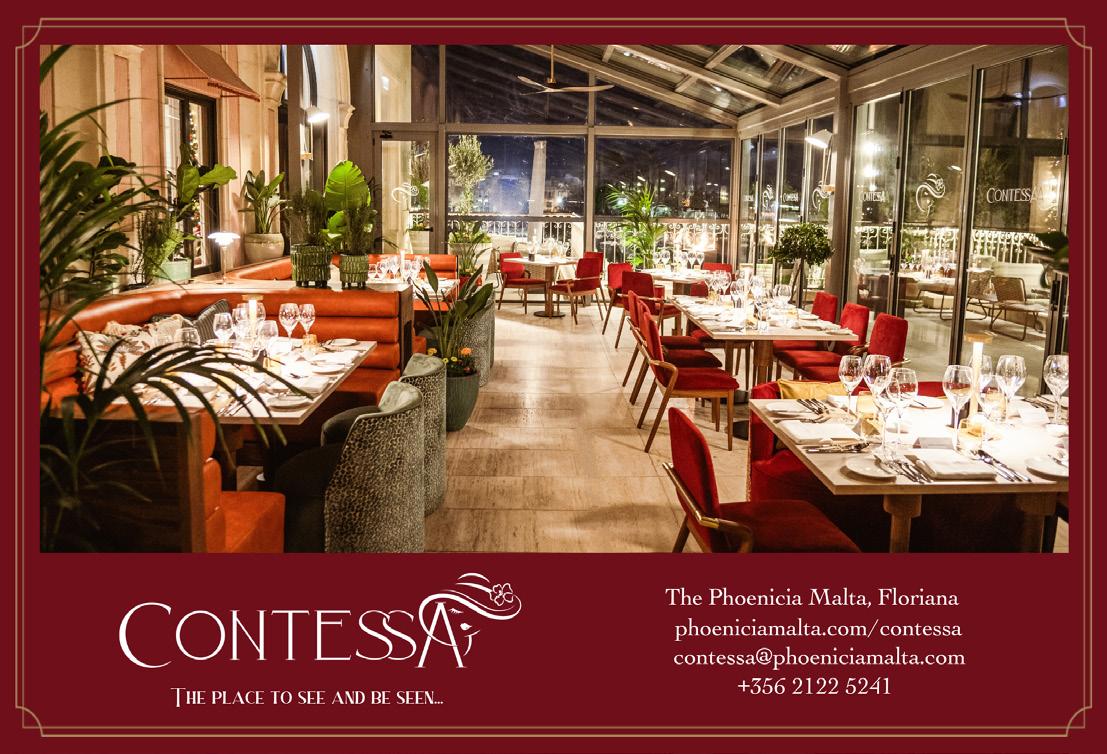

St George’s Bay, St Julian’s
Andrew's Bar is a freshly re-opened venue where fun is not optional, good food is compulsory, and building great memories is essential. Steeped in legacy, this is, in fact, Malta's oldest bar! The place is a go-to, and you're simply going to love indulging in the extensive menu, with a great local cuisine focus, serving traditional Maltese and modern dishes, such as pizza or pasta. Ideal for breakfast, lunch and dinner, it is also perfect for a quiet drink or two.
+356 2138 8031 info@andrewsbar.com
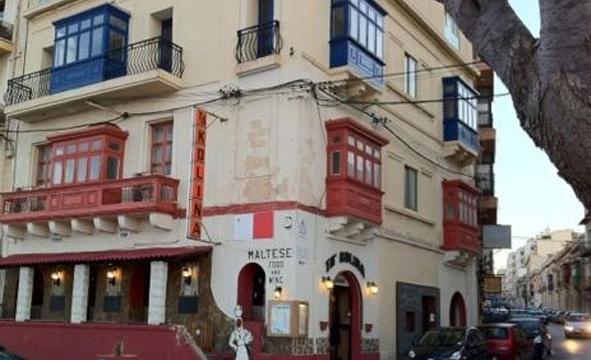
151, Tower Road, Sliema
Ta’ Kolina is a quaint, family-run restaurant on Tower Road (one of Sliema’s most popular spots). Open since 1974, it is a typical Maltese restaurant with a traditional Maltese interior and décor. A set menu comprising of traditional Maltese food offers a choice of starter, main dish, dessert and coffee for €24 per person. There is also a vibrant à la carte menu and daily display of fresh local fish. Dining here is a true Maltese experience for a reasonable price. Ta' Kolina is open for both lunch and dinner from 12 to 10:30pm.
+356 2133 5106 www.takolina.mt

+356 2010 5590
info@beachgardenmalta.com
Beach Garden Hotel, St. George's Bay, St Julian's, STJ 3302, Malta

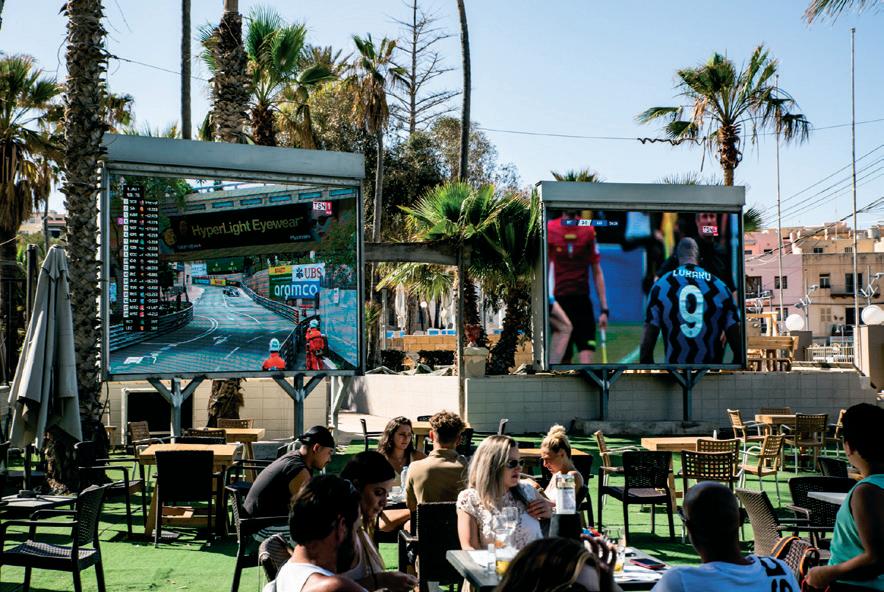
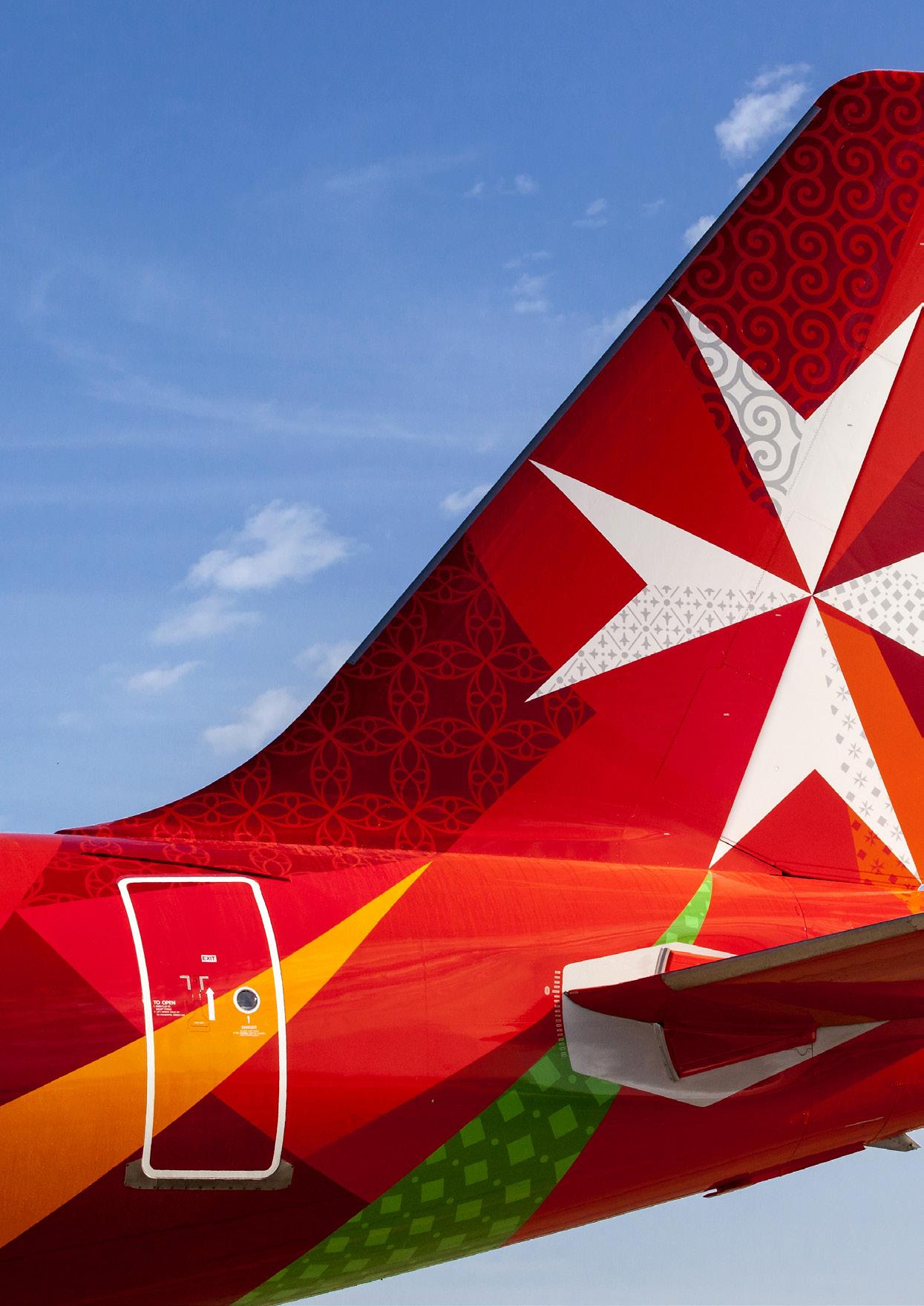
INSIGHT INTO WHAT'S GOING ON AND WHO'S WHO AT AIR MALTA; THE BEHIND-THE-SCENES AND HIGHLIGHTS, PLUS USEFUL FLIGHT INFORMATION TO KEEP PASSENGERS UP TO DATE ALL THE WAY.

The SHE Word started life as a podcast at the end of 2022 with the mission to have ‘Conversations Women Rarely Have, But Really Should’. The show format: four women sitting around a table discussing topics that are often taboo or frowned upon.
2023 brought Seasons 2 and 3 of the main show, hosted by founder, presenter, interviewer and producer Trudy Kerr, but also the Young Women’s Edition hit the small screen, hosted by 23-year-old Sasha Vella, tackling topics relevant to younger women with an appropriate tone of voice.
The show formula proved to be outstandingly successful, with over 5.7 million collective views, nearly a quarter of a million YouTube plays, over 80,000 Spotify plays and over 3.6 million Instagram reel plays alone.
The conversations tackle lighter topics, such as Women and Being a Woman, Women and Men, Women, Dating and Sex, but they also handle essentials, such as Sexual Health, Relationships, Menstruation, Menopause; and do not shy away from tougher subjects either, such as Narcissistic Abuse, Women and Identity, Mental Health and Domestic Abuse, bringing these important conversations to women around the world.
As The SHE Word heads into 2024, with more shows tailored to a broader female-centric audience, and airing spin-offs aimed at Women in Business and a show dedicated to the male audience, one ambition became clear: Let’s bring women together physically to empower and support each other.
And so, the TSW team is bringing The SHE Word LIVE to the Mediterranean Conference Centre, Valletta, on 24th and 25th May. Partnering with iCAN, The SHE Word LIVE brings women together from all over Europe, with some of the best world-renowned international keynote speakers, alongside Maltese and Malt abased speakers and panellists for a truly inspiring and empowering event for all women.
Day one – 24th May – is dedicated to ‘Empowering Women in the Workplace’, while the second day – 25th May – tackles the broader topic of ‘Empowering Women in the World’.
Head to The SHE Word socials for the links to grab a ticket for either one, or both days, for a truly uplifting, one-of-a-kind experience at Malta’s prestigious venue. Come as a group of friends, or as a work team, and be empowered together.
If The SHE Word sounds like something you would like to get involved in, either through following the shows, by participation, contribution, or partnership, get in touch through our media channels, or contact us on hello@thesheword.com
The SHE Word Season One is available to watch or listen to through the Air Malta Inflight Entertainment Service. To watch more of The SHE Word, head to www.youtube.com/@theinterviewer_thesheword or tune in to The SHE Word on Spotify. Follow, like, subscribe or contact us through Instagram, Facebook, Linkedin, or TikTok.
The Archbishop of Malta's first Delegate for Culture introduces us to his role and vision, sharing his enthusiasm for the upcoming Easter celebrations dotted around the islands, all available on inkontru.app.
Malta has always been a melting pot of cultures and beliefs, but perhaps this has never been clearer than today. Rapid societal shifts have led to the pouring in of an incredible diversity of communities on the tiny island, and the Church in Malta, it seems, wants to be a part of this reality not least through culture and the arts.
Tasked with facilitating dialogue between the Church and society's various cultural spheres, Mgr Claude Portelli is not resting on his laurels; a year into his new role as Delegate for Culture, he is certainly aware of the considerable task entrusted to him.
Speaking with inkontru.app co-founders Sarah-Lee Zammit and Godfrey Kenely, Mgr Portelli highlights the importance of culture as a binding element for communities to come together. "There is much space for healthy dialogue between the different faiths, which have found a home in Malta," Mgr Portelli argues. "Through cultural events, we can nurture these connections and strengthen the solidarity and understanding between our communities."
Culture is certainly an ideal bridge for bringing about interfaith and intercultural harmony. While some may see Malta as a summer island, leaving its colder months quiet and dull, a quick browse on inkontru.app, Malta's culture & lifestyle calendar, reveals the exact opposite. The cultural scene is well and truly alive throughout the year in Malta, particularly this month, when Easter celebrations bring the islands together for Christianity's most important feast.
"Very few places celebrate Easter like Malta," enthuses Mgr Portelli. "There is a reverence and passion for Holy Week events that can be seen everywhere during this period, and each village and town takes pride in its own unique traditions, from ĦażŻebbuġ's splendid Good Friday procession to Vittoriosa's Irxoxt on Easter Sunday. While these events are, of course, related to the Catholic faith, preparations involve thousands, and visitors flock to participate from all around the globe, irrespective of their own personal beliefs. This is how culture brings us together!"
With Easter-related events spread over a number of weeks across Malta and Gozo, inkontru.app will certainly come in handy to its users. Through its intuitive layout, comprehensive list of events, as well as video-based reviews and sneak peeks of anything that's going on in the islands' cultural scene, inkontru.app is the perfect tool to plan your stay in Malta, as well as the best nights out on the islands.
All Easter-related events are now on inkontru.app, which is available free of charge on all mobile phones with a web browser. Webapp registration is also free and may entitle users to exclusive discounts, offers and competitions thanks to its sponsors, including Malta's national airline, Air Malta.




HOW LONG HAVE YOU WORKED AT AIR MALTA AND IN WHAT ROLE?
I joined Air Malta back in October 2022 as Head of Marketing.
WHAT DO YOU MOST ENJOY ABOUT YOUR JOB?
Being part of and representing the national airline, and meeting and working with colleagues from all over the world.
AND WHAT’S THE MOST CHALLENGING ASPECT?
Working in aviation is a whole new ball game, and learning the ins and outs of this industry has been eye-opening to say the least. That, and keeping up with the highly volatile world that is marketing.
WHAT DO YOU ENJOY DOING IN YOUR FREE TIME?
Dance, dance and dance.
WHICH IS YOUR FAVOURITE EUROPEAN DESTINATION AND WHY?
Madrid holds a special place in my heart. It’s a charming city full of gorgeous architecture, good food and a buzzing nightlife.
WHICH IS YOUR FAVOURITE DESTINATION AND WHY?
The Land of the Rising Sun – Japan! It’s a country where every moment is filled with beautiful new discoveries and cultural differences, and where respect for people, food, nature and history remains unrivalled.
DO YOU HAVE A FAVOURITE LANGUAGE?
L-ilsien Malti ! Our beautiful native language – Maltese.
FAVOURITE GENRE OF MUSIC?
It really depends on my mood and what I am doing. I do tend to listen to indie/alternative rock and pop more often though
DREAM HOLIDAY DESTINATION?
As a child, I was always obsessed with wildlife, so I will stick to that and say somewhere in Africa, where I can experience watching the Big 5 game animals in their element.
WHERE WOULD YOU RECOMMEND VISITING IN THE MALTESE ISLANDS?
Sliema for brunch, Mdina for tea, Valletta for dinner… and Gozo for the weekend!
PREFERRED MALTESE DISH?
A classic – the crunchy ħobż biż-żejt (bread with oil), made using Maltese traditional sourdough bread and the best local ingredients.
FAVOURITE MALTESE EXPRESSION? ‘Bis-serjetà?’ – which translates to ‘seriously?’.



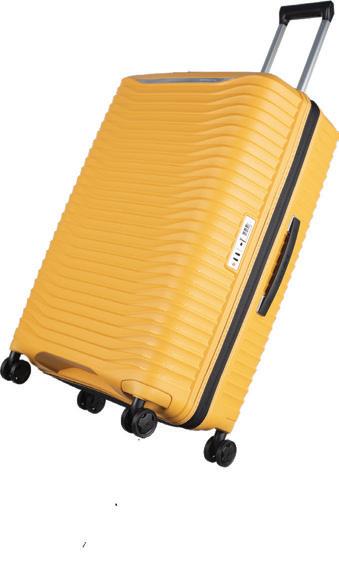








London LHR
Madrid
Amsterdam
London LGW
Paris CDG
Brussels
Paris ORY
Milan MXP
Lyon
Berlin
Dusseldorf
Munich
Zurich Vienna
Milan LIN
Rome Catania

QUANTITY: 2 IN FLEET
NUMBER OF SEATS: 180
ENGINES: CFM56-5B4/P
MAXIMUM TAKE OFF WEIGHT: 75.5 / 77 METRIC TONS
OVERALL LENGTH: 37.57M
WINGSPAN: 34.1M
CRUISING SPEED: MACH 0.78 (450KNOTS, 833KM/HR)
RANGE: 5,200 KM, 2,800 NMI, 3,250 SMI
FUEL CONSUMPTION: 2.27 LITRES PER 100KM PER PASSENGER*

QUANTITY: 6 IN FLEET
NUMBER OF SEATS: 180
ENGINES: CFM LEAP-1A
MAXIMUM TAKE OFF WEIGHT: 73.5 / 77 METRIC TONS
OVERALL LENGTH: 37.57M
WINGSPAN: 35.8M
CRUISING SPEED: MACH 0.78 (450KNOTS, 833KM/HR)
RANGE: 6,500 KM, 3,500 NMI, 4,025 SMI
FUEL CONSUMPTION: 1.8 LITRES PER 100KM PER PASSENGER*
* Based on a 1,000NM (1,860KM) journey with 180 pax and bags.
Alcohol consumed at high altitude can have a stronger effect than usual. Cabin crew are legally empowered to refuse to serve any alcohol to an intoxicated passenger and anyone under the age of 17. In extreme cases, crew may also temporarily confiscate the passenger‘s own drinks so that the passenger does not become a nuisance to the other passengers and crew. Furthermore, Air Malta is bound by international regulations which prohibit the embarkation or the carriage of drunken passengers. However, since you are reading this article, Air Malta‘s Flight Safety Committee is confident that you are a law-abiding and exemplary passenger. Indeed, the cabin crew may need your assistance to restrain another passenger in the unlikely event that he or she may act irresponsibly during the flight. The consumption of one’s own alcoholic beverages in-flight goes against Air Malta policy.
Smoking is prohibited from when you leave the departure terminal building until you reach the arrival terminal building. Smoking is allowed in designated areas only. Smoking is not allowed during any phase of the flight and in any area of the aircraft. Should you be aware of a passenger who has smoked in the toilet during the flight, please inform the cabin crew immediately so that they can check for any undetected fires. The use of electronic cigarettes (e-cigarettes) is not allowed on board Air Malta flights. Similarly, the use of naked flames on and around the aircraft is also prohibited.
The users of Air Malta services are obliged to comply with the European Regulation 679/2016 on the protection of personal data as well as the Chapter 586 of the Laws of Malta (Data Protection Act). It is the sole responsibility of the user to comply and in any case of non-compliance for payment of any penalties arising from such non-compliance. Based on the above-mentioned laws it is strictly forbidden to take photos or videos of passengers or the crew (without their explicit consent) and uploading them to the web.
Customer satisfaction is of the utmost importance at Air Malta and we are always looking for ways to improve your experience. Visit our website to answer a few short questions.
Visit www.airmalta.com/wearelistening
Subscribe to our newsletter or like our Facebook page to learn about our promotions, with fares starting from as low as €44 including taxes.
Visit www.airmalta.com for more information.
Upgrade to Air Malta’s Business Class for priority service. Members can make use of the special check-in counters for more leisurely and efficient boarding, enjoy access to the La Valette Lounge at Malta International Airport, and get more privacy with a separate in-flight cabin area.
Are you worried about not being able to fit everything you need into your suitcase? Stop stressing out and check out our extra baggage service. Simply book your extra baggage online and get the most out of your trip.
Visit www.airmalta.com/excess-baggage-en-gb
Enhance your comfort with extra legroom during your flight. This option gives you more space to relax in preparation for your trip.
Visit www.airmalta.com/information/services-by-air-malta/seat-selection
Are you passionate about a sport? We make it easy to travel and take your specialised equipment with you at a very minimal cost.
Visit www.airmalta.com/excess-baggage-en-gb
We also cater for large groups who want to travel together. If your group is larger than 10 adults, contact our Group Bookings team for special rates that you can’t get anywhere else.
Email groups@airmalta.com
Skip the line and check-in before you get to the airport. You may check-in online before you get to the airport, up to 24 hours prior to departure up until one hour before your flight.
Visit www.airmalta.com/information/check-in
T RANSMITTING PORTABLE ELECTRONIC DEVICES (PEDS)
Devices that can send or receive data by wireless means, such as mobile phones and tablets, may be used during all phases of the flight provided the device has 'Flight Mode' capability and that this is enabled. If the data transmission capability cannot be switched off (whilst the device is operating), the device itself must be switched off completely for the duration of the flight. Bluetooth wireless connectivity is allowed. Such devices shall be safely secured in the customers’ hand (handheld) or a pocket during taxi, take-off and landing. Accessories, such as headphones, must not obstruct access to the aisle. The use of Wi-Fi with Flight Mode enabled is permitted on some of our aircraft that are equipped with an in-flight entertainment system. The Cabin Crew will make an announcement on aircraft that are so equipped, to inform you when Wi-Fi can be enabled on your PEDs.
NON-TRANSMITTING PORTABLE ELECTRONIC DEVICES (PEDS)
These could include, but are not limited to, items such as DVD players, electronic games, music players and personal cameras. Such devices shall be safely secured in the customers’ hand (handheld) or a pocket during taxi, take-off and landing. Larger devices shall be stowed away safely during taxi, take-off and landing.
ARE THERE TIMES WHEN I CANNOT USE MY ELECTRONIC DEVICES?
Under certain circumstances, your Flight Crew or Cabin Crew may ask you to switch off all Personal Electronic Devices. This may happen during automatic landings, low visibility takeoff or landing, or during emergency situations.
I SHOULD INFORM THE CABIN CREW WHEN …
Your portable electronic device is damaged, becomes hot, produces smoke, is lost, or falls into the seat structure. If safe to do so, the device must be switched off immediately.
Larger devices (e.g. laptops) may be used during boarding and during the flight, however they must be switched off and stowed away safely during taxi, take-off and landing since they could hinder an emergency evacuation. 'Flight Mode' must be enabled. Use of Bluetooth connectivity is allowed. Use of Wi-Fi under Flight Mode is allowed on some aircraft which are equipped with an inflight entertainment system.
Personal headphones can be used during all phases of the flight. However, we ask you to remove your headphones during the safety briefing. For safety reasons, customers sitting in an emergency exit row must refrain from using headphones during taxi, take-off and landing.
If you require more information, please refer to the table below which includes a list of Personal Electronic Devices (PEDs) which can be used onboard Air Malta flights by phase of flight. Please do not hesitate to contact any member of our cabin crew if you have any further questions.
Boarding
Extended Ground Delay (when instructed by Flight Crew or Cabin Crew)
Taxi-out for Take-Off
During Safety Briefing Demonstration
Take-Off
Cruise
Circa 10 minutes to landing (Cabin Crew PA)
Landing
Taxi to Stand
* The use of Wi-Fi with Flight Mode enabled is permitted on some of our aircraft that are equipped with an in-flight entertainment system. Safety Notice: The carriage of damaged, defective or recalled lithium batteries or devices is prohibited on-board Air Malta aircrafts.





